Settings
This tutorial shows the development of a transport company starting in the year 1921. This particular game focuses on passenger and mail transport on rails, other means of transportation are not used. An additional goal is to focus on a somewhat realistic gameplay, i.e. the track layouts should look more or less like real railways. The goal is to connect all cities on the map, transporting mail and passengers. Both passengers and mail use the inbuilt feature to have destinations, so that they automatically choose the best connections for their needs, which also means they change trains where necessary.
It is often claimed that transporting passengers in the early game is not profitable. This is not true, since a passenger train practically never runs without passengers. A freight train runs fully loaded in one direction, but empty in the other. So when starting with sufficiently big cities, one can cash in lots of money with passengers just as well.
The game is based on a random 512x512 map with a low number of cities and a very low number of industries in a hilly terrain. NewGRFs are only used for optical reasons, except for the DBSetXL and the Total Town Replacement set. Only the original industries are used. The game makes use of a feature in JGR's patchpack to increase the length of a day (also available in OpenTTD starting with version 14.0).
Since the tutorial only focuses on a very general gameplay, difficulty settings can be chosen in an almost arbitrary way. However, breakdowns are disabled, since they are far too common in the game. Trains will be serviced in depots regularly (real steam trains need coal and even more water), this will be made sure by appropriate timetables. No other players (especially computer controlled ones) are active, since they would only mess up our game.
Note that I tend to build a lot and especially while pausing the game, since game time already runs quite fast and I want to be able to actually watch the trains on their way. But this is a personal habit, everyone may play as desired.
The first line
At the beginning, the first thing to do is to pause the game in order to take a long look at the map. OpenTTD provides a very helpful screenshot function to create a screenshot of the full map, which is exactly what is needed. Then, the map is loaded into some paint program to start painting around some ideas of what kind of rail network might be our end goal. In the first step, that can be really coarse, just showing which kinds of connections are planned to be created. For that we roughly follow the terrain and do not plan lines straight up across a mountain slope.
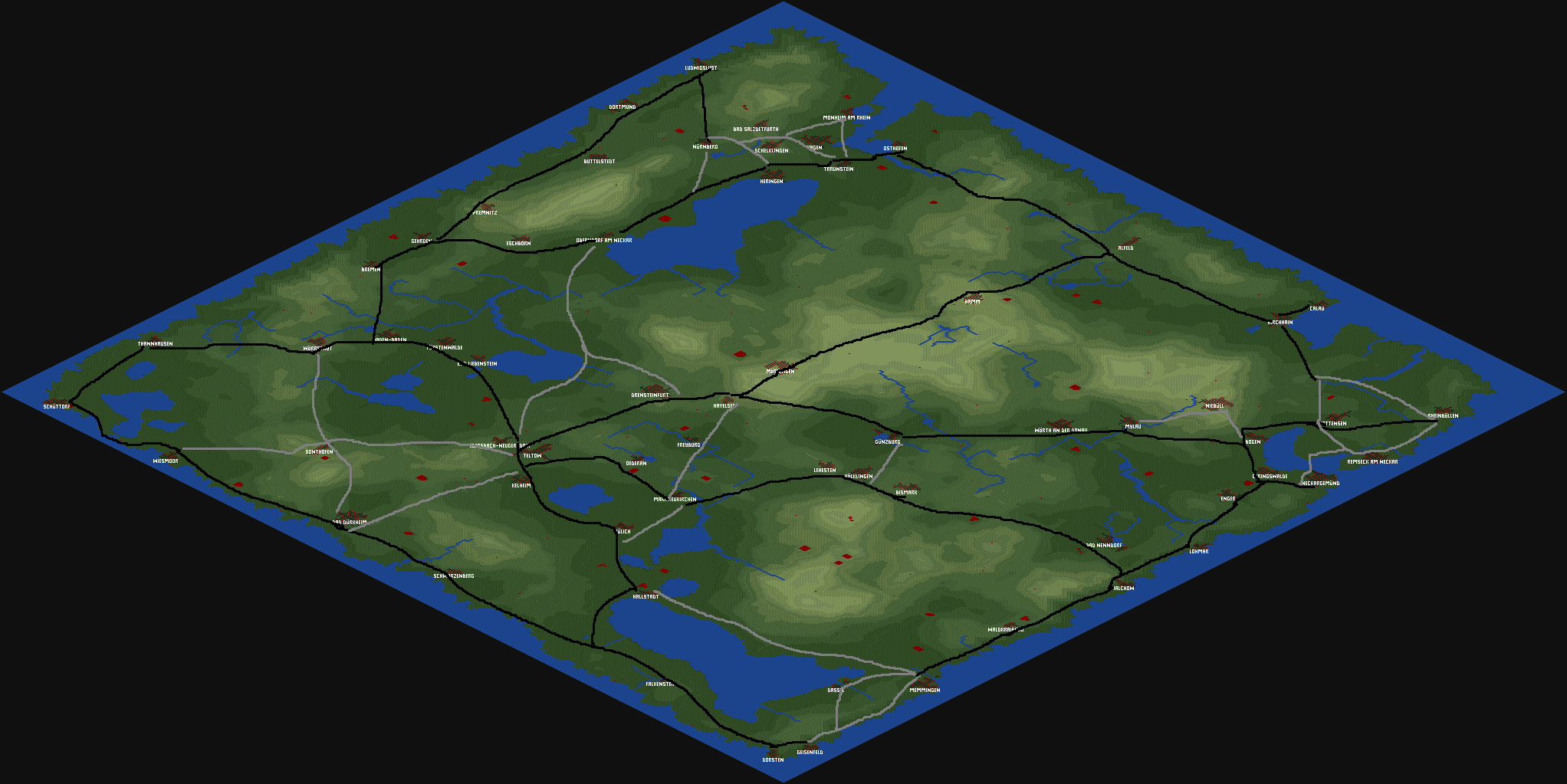
This results in the first draft (open the image in a new tab to see it in full size). The black lines are a rough outline of lines where I was already sure they will be created, gray ones are where I am not yet so sure. As can be seen, just by drawing that first rough sketch, one can already see where they might be important hubs where lines merge and where passengers may need to change trains. One such example in this map is around Teltow, to the left of the map center, where lots of black and gray lines meet. On the bottom right of the map there is the city of Memmingen, which might become a similar hub.
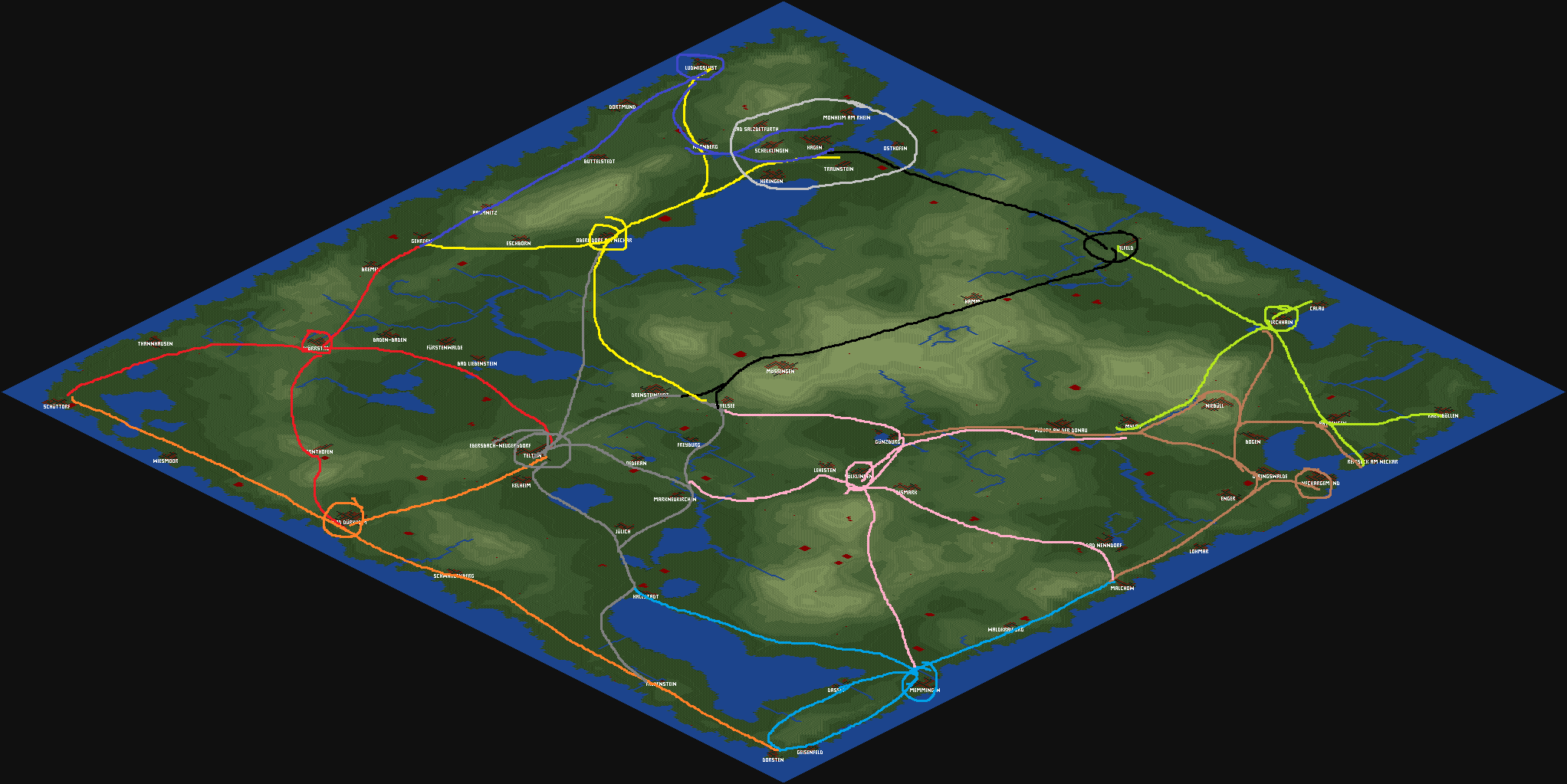
Before starting to build stuff, a more detailed planning is needed. The main questions that this more detailed plan needs to answer are: Where will lines start/end? Where will depots and train service infrastructure have to be placed? As we try to play in a realistic way, each engine shall have a home base, where the necessary services are done. This is how railway networks in the steam age worked: the engines were assigned to a specific depot, from where they were used for whatever trains had to be hauled from there. The train depot was not just required for constant maintenance, steam engines also required water and coal to be replenished often, so it would be highly unrealistic to start with a "local" train that runs from one end of the map to the other end - with the speed of the first engines it would take ages anyway, so this is something to be refined later in the game.
While working out the second plan, a close look at the actual terrain was done. When planning where to place train maintenance infrastructure, the available space is of paramount importance. In mountainous environment, setting this up at the start of the game might just be way too costly. After some back and forth in the painting program and sleeping over it for a night, the second plan was more or less finished. Of course, the plan could be laid in many different ways, this is one thing I came up with, in the next game on the same map I might consider lessons learned from this game session and lay out things differently.
The different colors depict the various lines that are serviced by trains located at the same train depot. This plan is just a plan, and plans will change over time, it just serves as a guideline to get going. For example, I still had no idea what to do with the many cities at the top of the map - they are close together, so should they even all get their own station? In any case, we will end up with about 10 to 11 main hubs where trains will be serviced. Whether the lines are then done in the way outlined here, or have to be done differently due to actual passenger demand is then to be found out during the game.
When drawing the whole plan, I also start to think where to place the station in relation to the city, so that it (hopefully) fits to the rail network I plan to go for. Of course, that depends on the terrain, local city councils and so on, all the plans will be revised along the way.
Having stated of all these rather boring things about planning, now on to an actual question: Where to start now? The starting location has to provide easy terrain, enough space to set up the first depot, and preferably several possible lines to be built to connect the first couple of towns. Due to terrain constraints, this came down to a decision between Teltow (gray) and Memmingen (light blue). After another closer look at the terrain, the city layout and the available space I decided to start conquering the map at Memmingen. From there I would then branch through the map, leaving the more complicated areas for later.
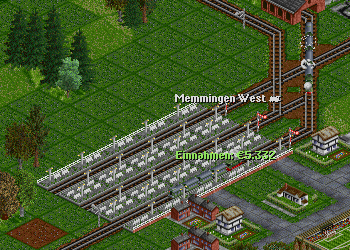 The station of Memmingen, our first hub. Of course you cannot see that much of a
hub here right now. Still, already by mid January of the first year there are three lines meeting here.
The station of Memmingen, our first hub. Of course you cannot see that much of a
hub here right now. Still, already by mid January of the first year there are three lines meeting here.
What is not visible that the signal on the right hand track uses a routing restriction. Trains coming from Dassel (to the left of the depot) and heading to the depot after stopping at Memmingen should not use the platform to the right. Only trains going to Geisenfeld must use it, otherwise we might run into issues with trains not correctly turning around. This is probably only a preliminary solution, but for now it will work well.
The routing restriction looks as follows:
Start
If train is entering from back of signal then
If station of next order is not Geisenfeld
Deny
End If
End If
EndTrains that fulfill the conditions (i.e. they come from the right AND head anywhere but Geisenfeld after their stop in Memmingen) will treat the signal as dead end. The condition with the signal side is needed, otherwise trains coming from Geisenfeld and heading for the depot will also treat this signal as dead end, but in that direction it should be treated as signal without routing restriction. In the same way, access to the other platform is restricted so that trains going to Geisenfeld only use the right hand platform.
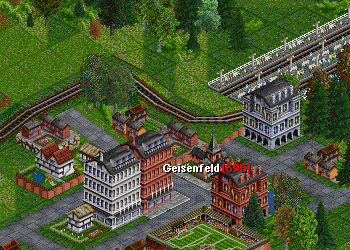 The first line runs from Memmingen along the coast to the South, passing Geisenfeld and (for now) ending in Dorsten. As you can see, the local city council was not too happy
with what we did there and forbade demolishing works. That resulted in a rather suboptimal track outline to start with. The station already has two platforms, but we're still
waiting to make some more money to be able to doubletrack the line - this was already required as passenger demand was way higher than expected.
The first line runs from Memmingen along the coast to the South, passing Geisenfeld and (for now) ending in Dorsten. As you can see, the local city council was not too happy
with what we did there and forbade demolishing works. That resulted in a rather suboptimal track outline to start with. The station already has two platforms, but we're still
waiting to make some more money to be able to doubletrack the line - this was already required as passenger demand was way higher than expected.
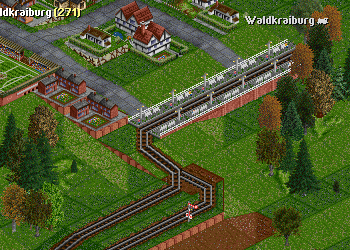 The other end of our network after the first quarter is at Waldkraiburg, right next to the edge of the map, a little North of Memmingen. The track is mostly doubletracked
already, just the station itself consists of a single platform. However, that would soon change.
The other end of our network after the first quarter is at Waldkraiburg, right next to the edge of the map, a little North of Memmingen. The track is mostly doubletracked
already, just the station itself consists of a single platform. However, that would soon change.
The first quarterly results came in (remember, I am playing with an increased daylength to get more time out of playing with the early steamers). Almost a 100k income - that is not too bad, considering it is just three trains doing the work. It will allow us to extend the network, buy more trains and hopefully provide a better service, as both passengers and mail are queuing up everywhere.
Adding lines
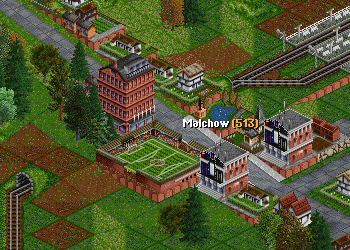 As we cannot extend the line at Geisenfeld due to uncooperative city councils, we instead continue the line at Waldkraiburg towards Malchow. The latter city is situated rather
unfortunately at the slopes of a mountain,
so the station has to be built a bit away from the city center. Also, a rather expensive tunnel is needed to get there, in addition to a couple of bridges to make the climb
towards Waldkraiburg easier. The tracks around Waldkraiburg were also changed to reduce the number of curves, and the whole line was double-tracked. Once everything was done, the only important change
was to adapt one single order list - as all three trains on the line share the same list, they automatically take over the change. Then the names of the trains were adapted, and now
we have completed that branch which is to be served by engines from the Memmingen depot. This is now the longest line of our network, and the comparably slow
class 92 is getting to its limits here.
As we cannot extend the line at Geisenfeld due to uncooperative city councils, we instead continue the line at Waldkraiburg towards Malchow. The latter city is situated rather
unfortunately at the slopes of a mountain,
so the station has to be built a bit away from the city center. Also, a rather expensive tunnel is needed to get there, in addition to a couple of bridges to make the climb
towards Waldkraiburg easier. The tracks around Waldkraiburg were also changed to reduce the number of curves, and the whole line was double-tracked. Once everything was done, the only important change
was to adapt one single order list - as all three trains on the line share the same list, they automatically take over the change. Then the names of the trains were adapted, and now
we have completed that branch which is to be served by engines from the Memmingen depot. This is now the longest line of our network, and the comparably slow
class 92 is getting to its limits here.
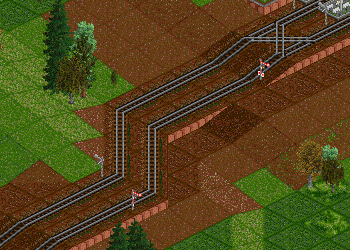 This screenshot shows the reshaped tracks leading towards Waldkraiburg, as can be guessed the city council was not too happy with that. On the other hand, no further work was
needed for the next years, so that wasn't much of a problem. The relevant idea in the whole network is that there are 7-8 flat tiles between any slopes, so that a train even
with a weak engine has a chance at negotiating the hills.
This screenshot shows the reshaped tracks leading towards Waldkraiburg, as can be guessed the city council was not too happy with that. On the other hand, no further work was
needed for the next years, so that wasn't much of a problem. The relevant idea in the whole network is that there are 7-8 flat tiles between any slopes, so that a train even
with a weak engine has a chance at negotiating the hills.
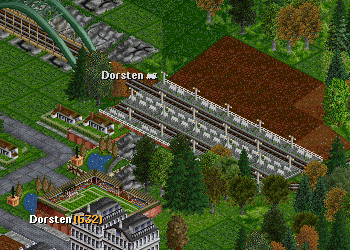 The next step is the connection from Dorsten to Dassel. While it is only a small branch line with little traffic, it is quite cumbersome for passengers from Dassel to get to Dorsten:
They have to go to Memmingen, change trains and then go via Geisenfeld. This takes quite some time. Since a direction connection with a single track is not too much of a problem,
we simply build that. The station of Dorsten will have to be extended later on anyway once we start going along the Southwest border of the map, so why not just prepare straight away?
The next step is the connection from Dorsten to Dassel. While it is only a small branch line with little traffic, it is quite cumbersome for passengers from Dassel to get to Dorsten:
They have to go to Memmingen, change trains and then go via Geisenfeld. This takes quite some time. Since a direction connection with a single track is not too much of a problem,
we simply build that. The station of Dorsten will have to be extended later on anyway once we start going along the Southwest border of the map, so why not just prepare straight away?
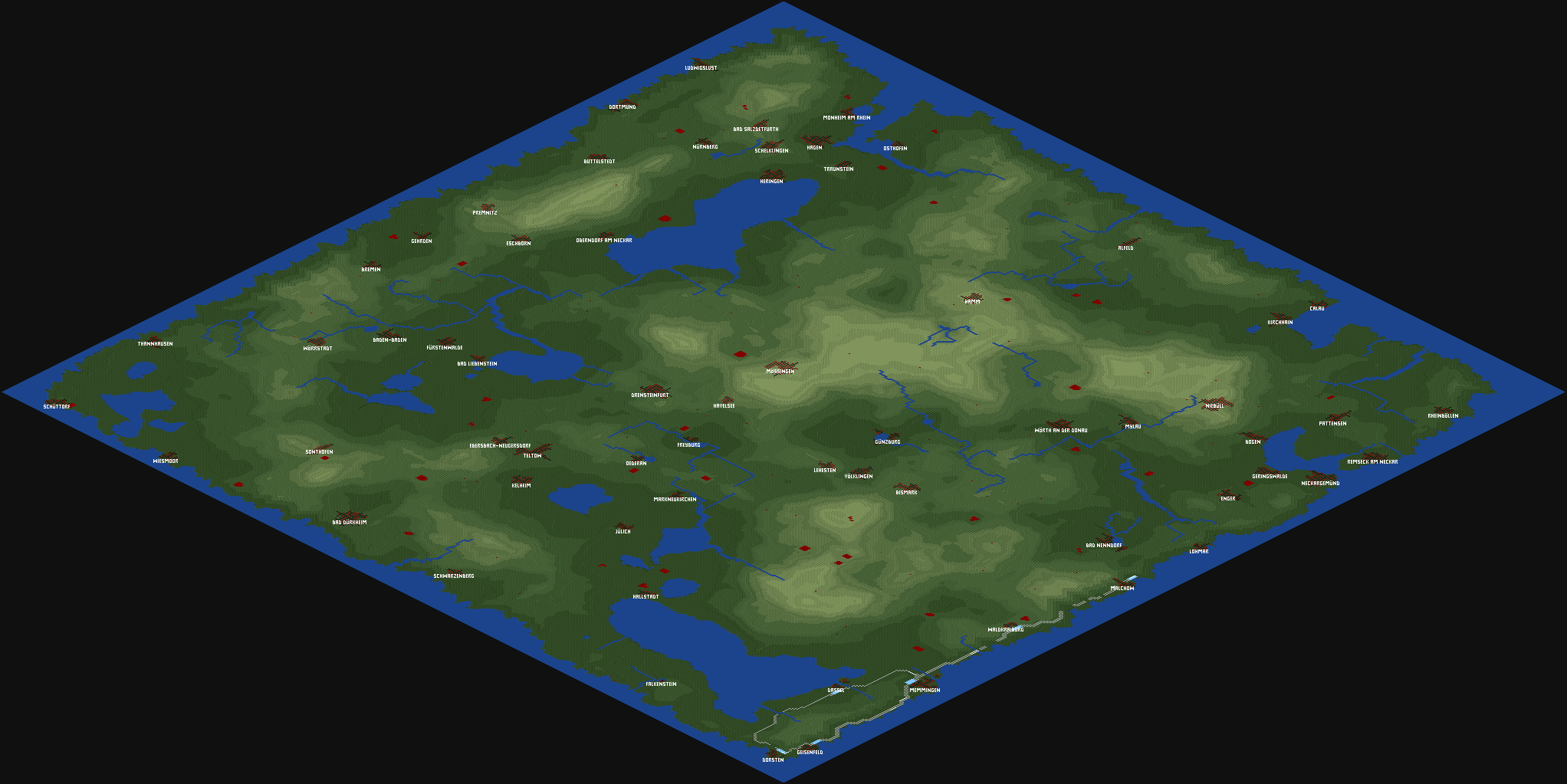
The map after three quarters of the first year shows what we achieved so far. When comparing that with the original plan, the only thing missing for the lines planned for the depot at Memmingen is the line towards Hallstadt. And that is exactly what was built next, taking about three in-game months. At the end of the first year the line to Hallstadt is fully operational and two trains have been set up to run there. Meanwhile the loan has been paid back, from now on no new loan will be taken. The trains have made about 1.1 million bucks, most of which went into building tracks and buying rolling stock. So far there are nine trains running on four lines. From the original plan the light blue parts are done. Next goal: Finish the next depot section, i.e. all lines of one color. As Teltow (the gray tracks) had been in the running as starting point, this is now where we'll continue.
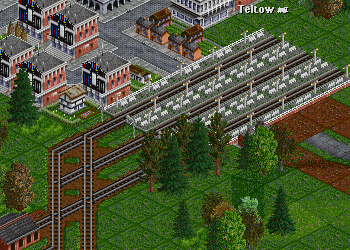 The first new line will lead from Teltow via Kelheim and Jülich to Hallstadt, where there is then a connection to the rest of the network. Unfortunately we need to bulldoze quite
a bit at Teltow so that the station is near the city center, which causes quite the uproar with the city council. Well, we're used to that by now, Geisenfeld still has not forgiven
us the audacity to build a station in their wonderful town... In any case, the new line is swiftly constructed, and at the same time we get the offer to test a new engine,
class 75,
which is way faster than the class 92 that is currently in use. So, depot Teltow will be given newly bought
class 75 engines, while depot Memmingen will have to wait a bit, until enough money is available.
The first new line will lead from Teltow via Kelheim and Jülich to Hallstadt, where there is then a connection to the rest of the network. Unfortunately we need to bulldoze quite
a bit at Teltow so that the station is near the city center, which causes quite the uproar with the city council. Well, we're used to that by now, Geisenfeld still has not forgiven
us the audacity to build a station in their wonderful town... In any case, the new line is swiftly constructed, and at the same time we get the offer to test a new engine,
class 75,
which is way faster than the class 92 that is currently in use. So, depot Teltow will be given newly bought
class 75 engines, while depot Memmingen will have to wait a bit, until enough money is available.
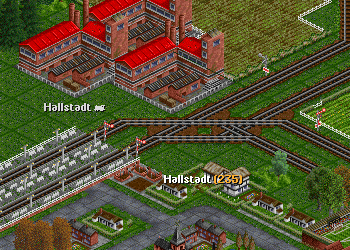 Three months later the engines are all replaced. Moreover, Teltow is bustling with passengers, far too many for one train to handle it. Fortunately money is not that tight anymore
and we can invest in further rolling stock. With Teltow producing passengers left, right and center the new rolling stock is directly put to good use, resulting in an explosion in
our company income. This now allows us to buy further trains to ensure all the new passengers and mail bags are delivered to their destinations. That means not just between
Teltow and Hallstadt, but also between Hallstadt and Memmingen, and from there throughout all the other lines. Luckily, we already prepared our network to handle more trains. So
this is now just a matter of adding more trains to the lines and checking whether the passengers get distributed well. This also results in Memmingen station becoming quite full,
so whenever the next lines are added that go there, the station will need a major extension and renovation.
Three months later the engines are all replaced. Moreover, Teltow is bustling with passengers, far too many for one train to handle it. Fortunately money is not that tight anymore
and we can invest in further rolling stock. With Teltow producing passengers left, right and center the new rolling stock is directly put to good use, resulting in an explosion in
our company income. This now allows us to buy further trains to ensure all the new passengers and mail bags are delivered to their destinations. That means not just between
Teltow and Hallstadt, but also between Hallstadt and Memmingen, and from there throughout all the other lines. Luckily, we already prepared our network to handle more trains. So
this is now just a matter of adding more trains to the lines and checking whether the passengers get distributed well. This also results in Memmingen station becoming quite full,
so whenever the next lines are added that go there, the station will need a major extension and renovation.
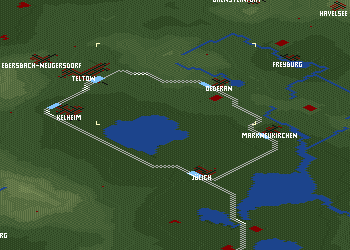 The next line based on Teltow depot will be a loop via Oederan and Markneukirchen to Jülich, offering some additional ways to get from here to there. Once it is in place, one could
also think about introducing a circle line from Teltow via Kelheim and Jülich continuing to Markneukirchen and back to Teltow. That line will probably stay kind of a branch line,
nevertheless, it was built fully double-tracked before I realized that this would probably be overkill.
The next line based on Teltow depot will be a loop via Oederan and Markneukirchen to Jülich, offering some additional ways to get from here to there. Once it is in place, one could
also think about introducing a circle line from Teltow via Kelheim and Jülich continuing to Markneukirchen and back to Teltow. That line will probably stay kind of a branch line,
nevertheless, it was built fully double-tracked before I realized that this would probably be overkill.
The next line would be single-tracked, a branch line between Teltow and Ebersbach-Neugersdorf (yeah, German city names can be weird). This one, the line that is, is really short and just loops outside Teltow to tackle a rather steep grade up to the other town. During the construction of that line, Teltow also receives a waypoint station to simplify the signal restrictions used to distribute the trains to the correct platforms. This is just a preliminary solution, from now on any new lines will receive proper station designs including roofs, benches and other amenities that passengers would not want to miss. In the first year I skipped all of that to concentrate on earning initial money, by now we're almost millionaires, so we can do things properly.
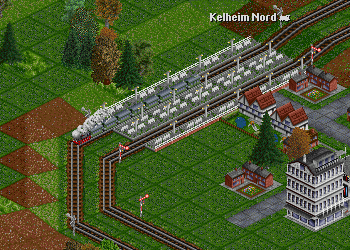 By now we are almost completely done with the lines that Teltow depot is associated with. One line going towards the top of the map and the yellow parts is missing, as is another loop
line heading in the general direction of Drensteinfurt and then circling back towards Markneukirchen. There is also a connection between Hallstadt and Falkenstein to be considered,
but the latter is a tiny village with one road and one building, so that can be kept for later. So let's go for the loop line via Drensteinfurt.
By now we are almost completely done with the lines that Teltow depot is associated with. One line going towards the top of the map and the yellow parts is missing, as is another loop
line heading in the general direction of Drensteinfurt and then circling back towards Markneukirchen. There is also a connection between Hallstadt and Falkenstein to be considered,
but the latter is a tiny village with one road and one building, so that can be kept for later. So let's go for the loop line via Drensteinfurt.
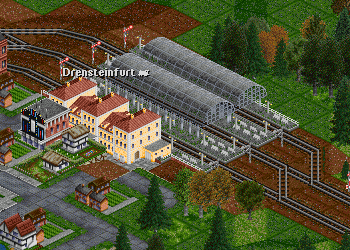 It turned out that this line was very difficult to build, mainly due to the terrain. It required quite a bit of terraforming and some rather big bridges.
Needless to say that the city councils did not like this line a lot. Still, Drensteinfurt
is going to be a rather busy hub with (still to be built) lines in several directions, so it was better to prepare the tracks with all bells and whistles right from the beginning.
Between Havelsee and Freyburg (just like in reality located near a river, in reality that's quite the area for growing wine) the track describes a rather huge S-bend to tackle the
height difference. And finally the track joins the existing line between Oederan and Markneukirchen. Now it only took some convincing of the city council in Markneukirchen to allow
us to add another platform to the station.
It turned out that this line was very difficult to build, mainly due to the terrain. It required quite a bit of terraforming and some rather big bridges.
Needless to say that the city councils did not like this line a lot. Still, Drensteinfurt
is going to be a rather busy hub with (still to be built) lines in several directions, so it was better to prepare the tracks with all bells and whistles right from the beginning.
Between Havelsee and Freyburg (just like in reality located near a river, in reality that's quite the area for growing wine) the track describes a rather huge S-bend to tackle the
height difference. And finally the track joins the existing line between Oederan and Markneukirchen. Now it only took some convincing of the city council in Markneukirchen to allow
us to add another platform to the station.
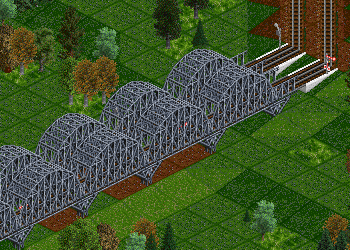 It's not easy to see here, but there's signals on the bridge. This is extremely helpful to make longer bridges a viable solution in the game (only available in JGR's patchpack).
It's not easy to see here, but there's signals on the bridge. This is extremely helpful to make longer bridges a viable solution in the game (only available in JGR's patchpack).
Passengers had less issues with the new line, the station of Drensteinfurt was crowded almost immediately, requiring a second train to be added to the line. With that, the depot of Teltow was fully operational. The whole process took about half a year of game time (remember: daylength!) and improved our revenue considerably, as several rather large cities were added to the network.
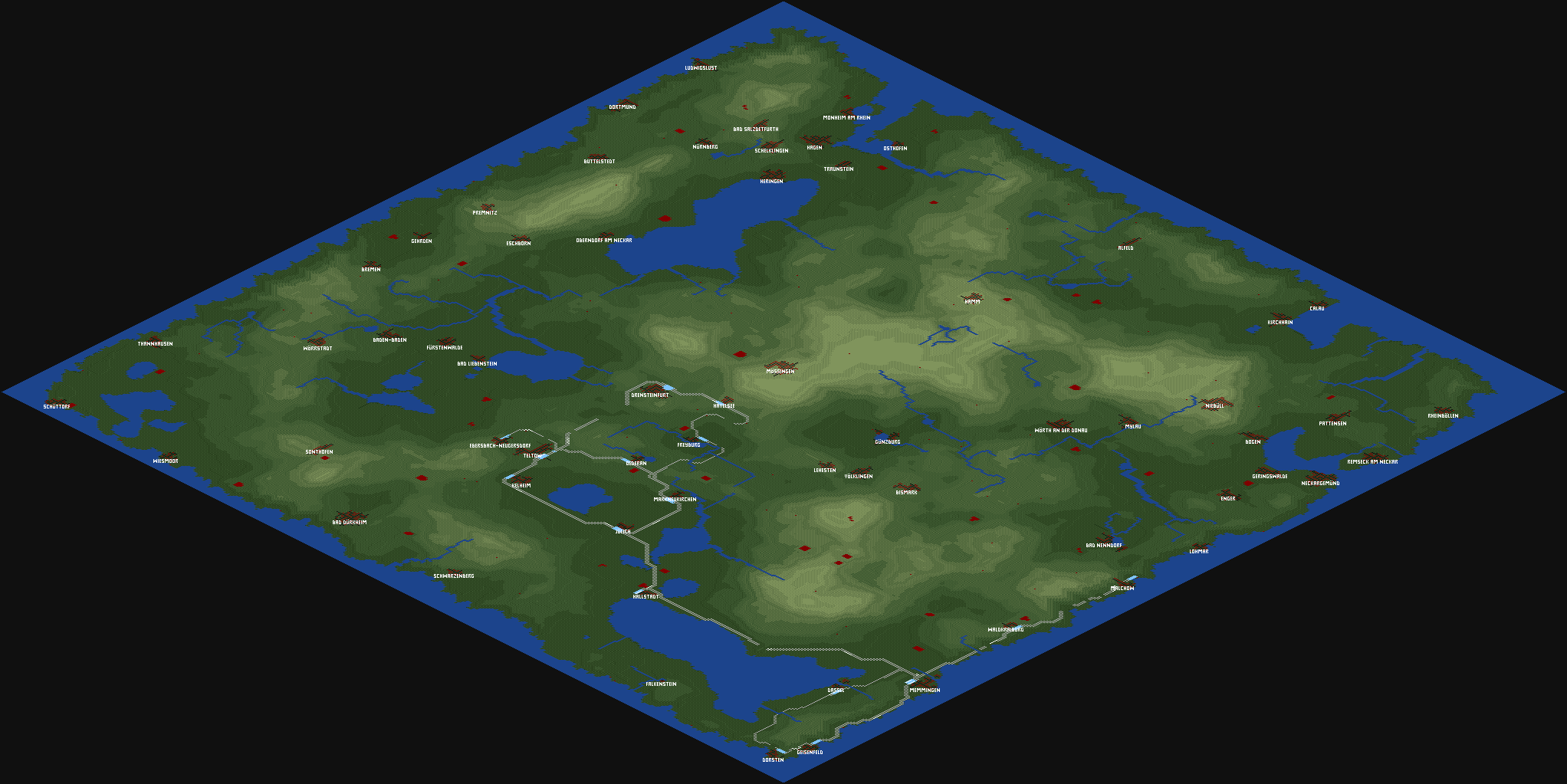
In order to expand the network, viable possibilities are (referring to the overview map at the beginning of the article) the red lines (depot Wörrstadt), orange (depot Bad Dürkheim), yellow (depot Oberndorf am Neckar), pink (depot Völklingen) or brown (depot Neckargemünd). I decided to continue with the orange one, because it is connected to both Teltow and Memmingen (via Dorsten). That would have been true for pink as well, but there the terrain is more complicated.
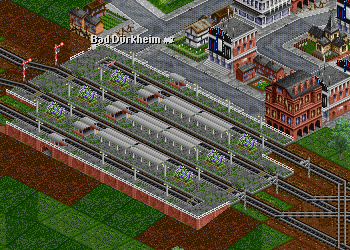 Setting up the three orange lines was not much trouble, it just depleted our funds. The uncooperative city council in Geisenfeld was still getting on my nerves, the would not want
to see the forest for all the trees I had put there... A similar problem plagued me at Bad Dürkheim, at least there I had already set up the station in bigger ways and did not
have any immediate trouble to deal with. While setting up the orange lines from Bad Dürkheim along the bottom left border of the map I also looked back at Memmingen and found that
this station needed an immediate improvement - bigger, better, newer. It was still the most busy station of the map at that point, and it showed. Trains were blocking each other
trying to enter the station and also the depot, which in itself should be made bigger, as it is simply unrealistic to have a train of five tiles vanishing in a depot with one tile.
Setting up the three orange lines was not much trouble, it just depleted our funds. The uncooperative city council in Geisenfeld was still getting on my nerves, the would not want
to see the forest for all the trees I had put there... A similar problem plagued me at Bad Dürkheim, at least there I had already set up the station in bigger ways and did not
have any immediate trouble to deal with. While setting up the orange lines from Bad Dürkheim along the bottom left border of the map I also looked back at Memmingen and found that
this station needed an immediate improvement - bigger, better, newer. It was still the most busy station of the map at that point, and it showed. Trains were blocking each other
trying to enter the station and also the depot, which in itself should be made bigger, as it is simply unrealistic to have a train of five tiles vanishing in a depot with one tile.
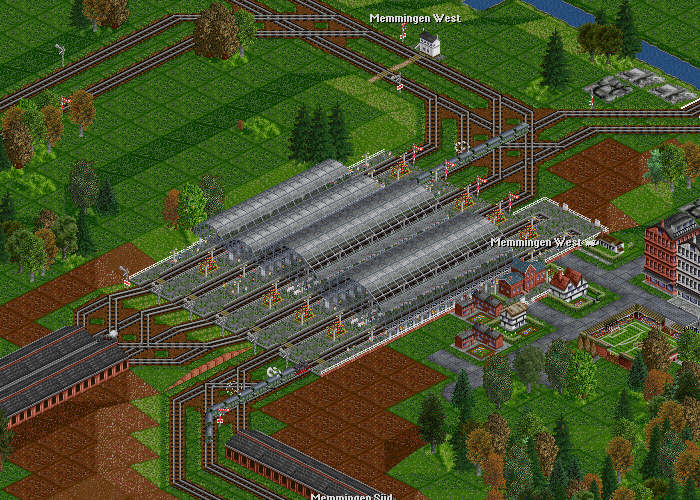
Fortunately the city council of Memmingen had no issues with these plans, so the station rebuild was done. The station now provides six platforms, two for the trains towards Geisenfeld and Dorsten, the others are for the trains leaving the station to the Northeast and Northwest. The depot locations were improved, and terminal platforms received buffer stops. Also the platform lengths were increased to be prepared for later times with longer trains.
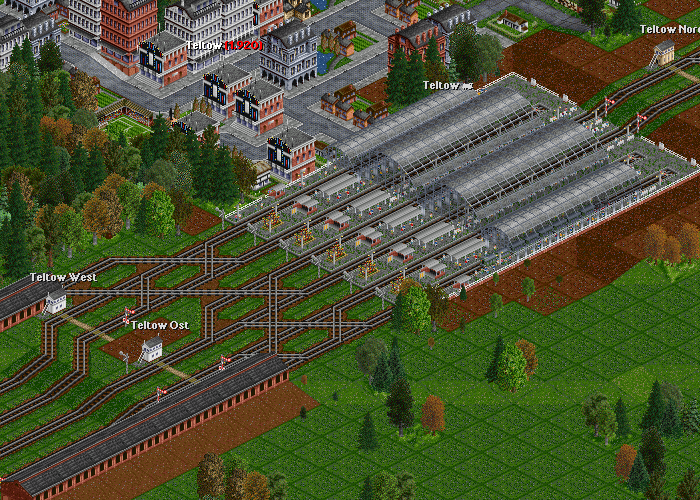
As that had worked so well, the same treatment was due for the station of Teltow. City council was - you guess it - not so cooperative, but finally it was done, and the city council can now spend their time counting trees. The changes were similar to Memmingen - increase station size, reduce the amount of crossing paths to improve efficiency, and a bit of eye candy here and there.
At the end of the second year we have 1.5 million bucks to spend on the next extensions of the network. At the same type, a new engine is introduced, the class 38 (or Prussian P8), a cheap and fast passenger engine. That is exactly what we need to improve our transport ratings. The orange lines are improved first, not only by replacing the existing engines, but also by adding further trains, since the stations are full of waiting passengers.
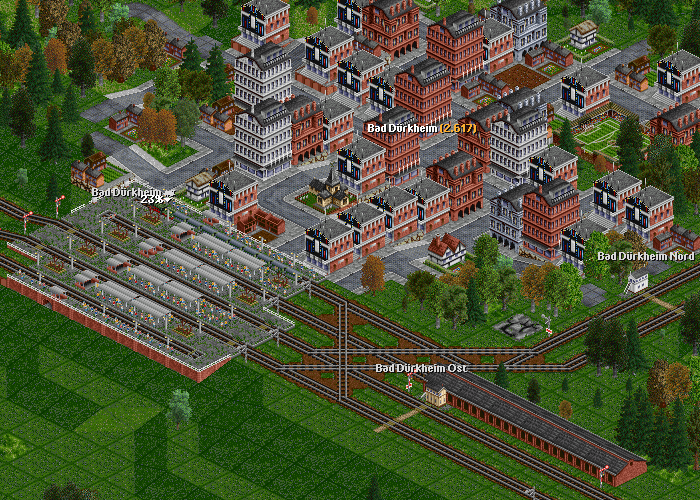
By now it is spring 1923, time to look again to the city council of Geisenfeld. By now we have planted more trees than can be counted, but to no avail. Since that approach did not work, we will now try something more capitalistic. We provide an incentive for the city council to be more in favor with our wishes. Countable incentives, printed pieces of paper... No, we are definitely not bribing officials ;-) Unfortunately, some overly active detective did not like our activities, so now the city council does not even accept our hard earned money for several months. Well, not my problem, they are losing out on an improved public transportation...
Anyway, time to build the next depot area. This time the choice is obvious, as we have the grey and orange parts done, we can now tackle the red lines around the city of Wörrstadt. This one will likely see quite some traffic towards Teltow as there are three big cities on the way there. All the more reasons to tackle this project create more stations that are bursting with waiting passengers...
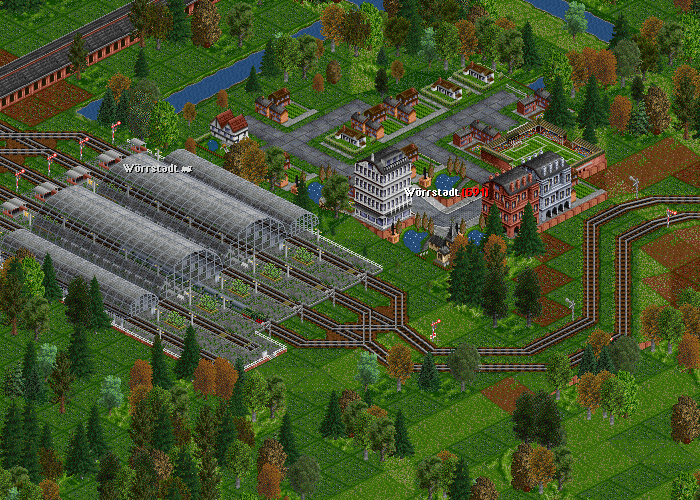
Building these lines was now rather simple, the lines between Wörrstadt and Bad Dürkheim as well as the line to Schüttorf was built single-tracked, the line towards Teltow connecting several large cities was double-tracked directly, and upon inauguration four trains started their duties on it. The line to Gehrden via Bremen proved to be rather interesting due to topographic challenges. The line makes quite the detour around a mountain range to slowly descent to Bremen, compared to the simple line I painted on the map originally. In mid 1923 all four lines were up and running and there was still more than 1.5 million bucks to be spent on further network improvements.
Before tackling the next depot and the associated lines, some loose ends were to be taken care of. The first was the replacement of class 75 with class 38 to gain 20 kph top speed throughout the network. That was achieved by August 1923. The other loose end was the missing line between Hallstadt and Falkenstein. That was also added in the same month, with trains traveling between Teltow and Hallstadt now being extended to Falkenstein. There, passengers can now change trains to get to Dorsten or Schwarzenberg.
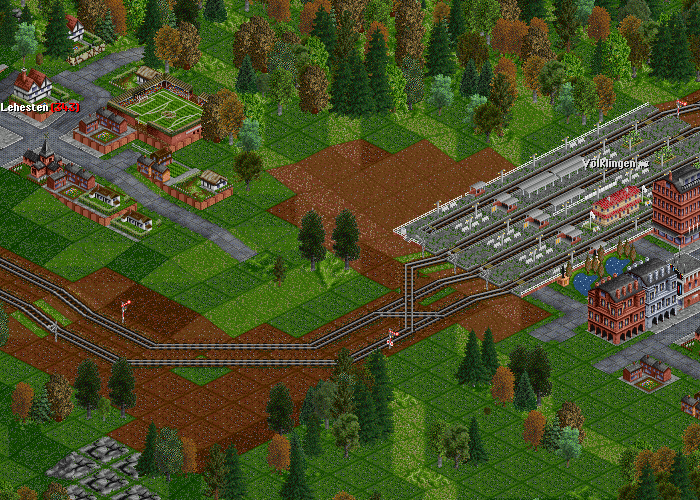
As we still could not convince the city council of Geisenfeld, the next goal was the pink network around Völklingen. That contains five different lines, so plenty of things to be built and certainly more useful than funding another pointless forests on the sloes around Geisenfeld. Since the fruitless negotiations with the city council of Geisenfeld had cost quite some money, building the new lines around Völklingen took well into 1924.
In between the single-tracked line between Wörrstadt and Schüttorf had to be doubletracked and two additional trains had to be put into service, as passenger numbers were way higher than anticipated. The same thing happened to the line between Wörrstadt and Bad Dürkheim, where passengers were also keen on using the train. In Teltow there was a huge jam concerning mail, which also had to be solved by adding more trains to the relevant lines - typically these would be pure mail trains.
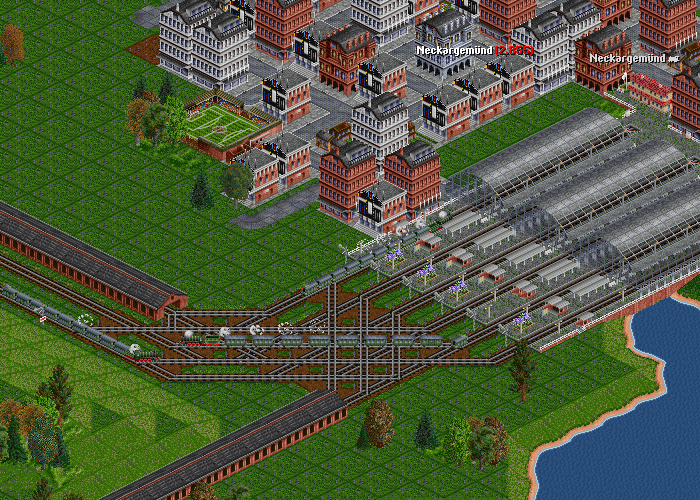
The station of Teltow could also do with even more platforms, also the way the depots are laid out causes issues. However, as usual the city council prohibits us from improving the situation. Well, we do not even have half the map connected, so we can focus on the brown network next. First step was a rather large terminal station at Neckargemünd, from where the first lines towards Malchow and Wörth an der Donau were set up. At Malchow there are connections to Völklingen and Memmingen, Wörth an der Donau also got a connection from Völklingen. Another line curves around the large lagoon via Bogen and Pattensen to Remseck am Neckar. This proved to an interesting challenge, as passengers piled up in the small station of Geringswalde as there most changes into all directions can be done, even though the city itself is rather small. That was not really foreseen by me, so the station had to be expanded rather soon after it had been constructed in the first place. With all trains from Neckargemünd passing through the station, that section was the first four-tracked line on the whole network.
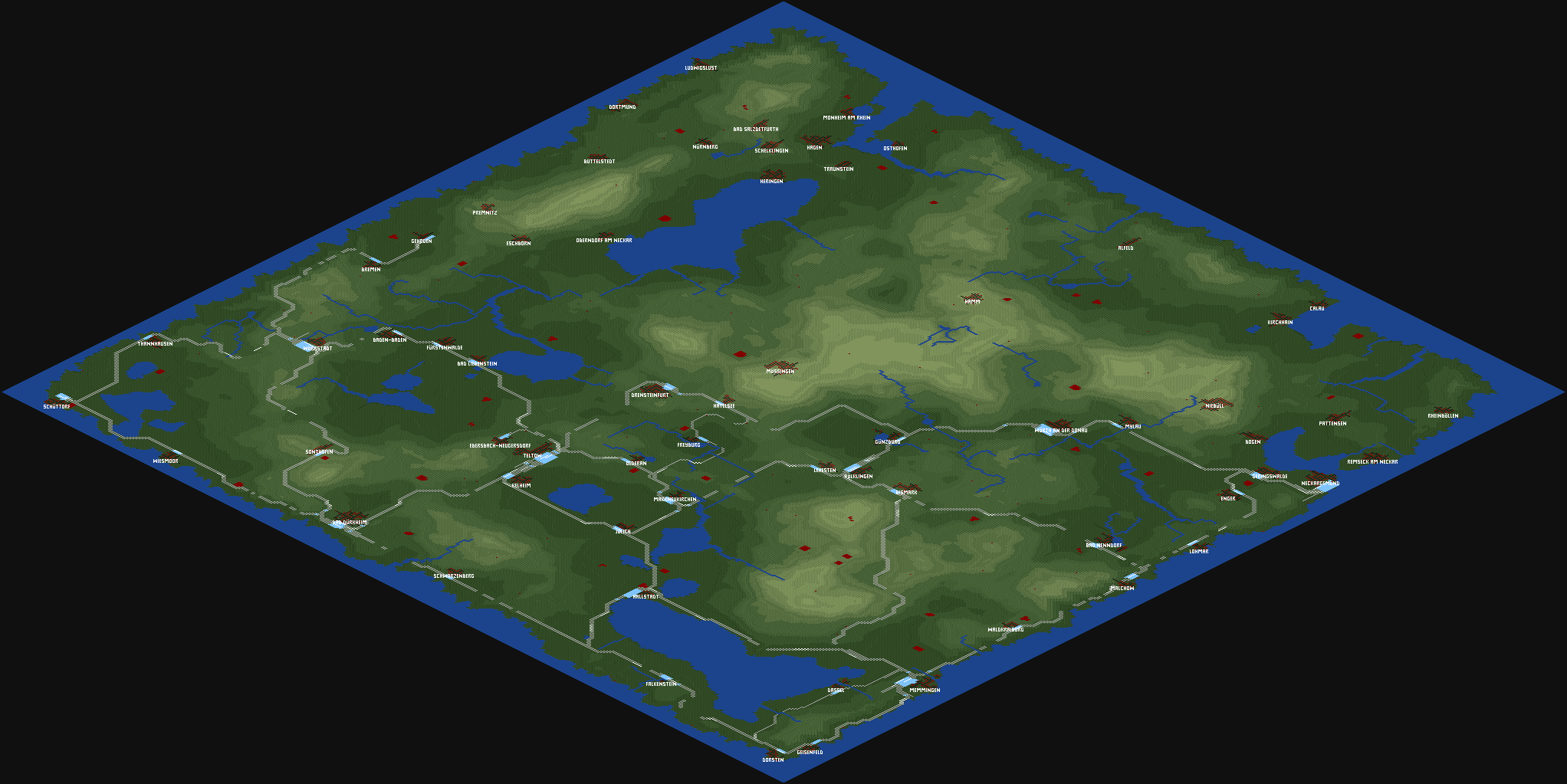
The final line of the Neckargemünd depot network was to connect Niebüll, which very inconveniently is situated on top of steep mountain (funnily enough the real world Niebüll is on the shores of the North Sea, it cannot get much flatter than that in Germany). Fifteen height levels difference in a distance of about 30 tiles to Bogen which is on sea level. To get up there in a realistic way will require quite a bit of engineering. Nevertheless, it was not a problem, but a challenge, and a fun one at that. The main problem was, you guessed it, that it required some more terraforming, which in turn had effects on the city councils...
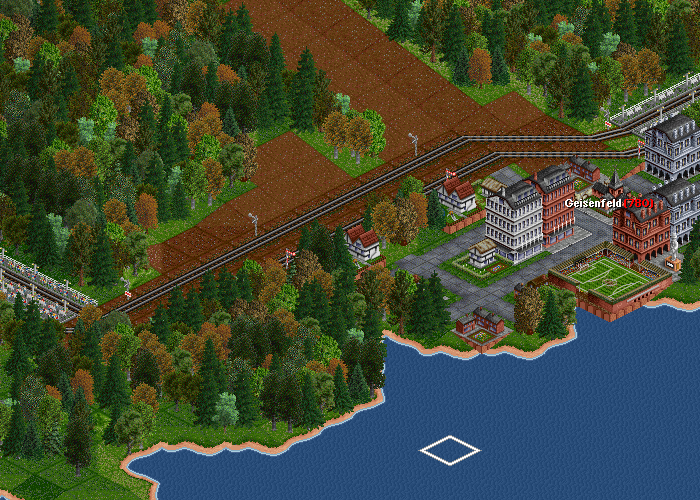
In June 1924 we finally managed to change the layout at Geisenfeld. The whole line to Dorsten could finally be doubletracked and with some more straights, which now open up possibilities to increase the size of the station at Dorsten. Before the latter step was done, Teltow had to be increased in size, also the way the depots were arranged caused jams and lots of issues with crossing paths. After a lot of money had been spent on stubborn local politicians, additional platforms were added and the location of the depots was changed, also more depots were added to not have a single depot being overloaded with trains - after all, Teltow is the most busy station in the network.
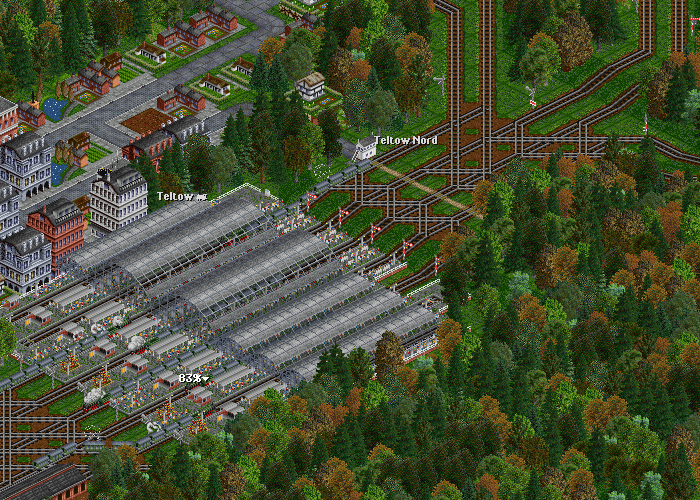
The station of Teltow received an upgrade in late 1924. It would not be the last, as there are lines in several directions meeting here. The problem typically is not the number of platforms, but trains blocking each other when entering and exiting, making the station less efficient than it could be.
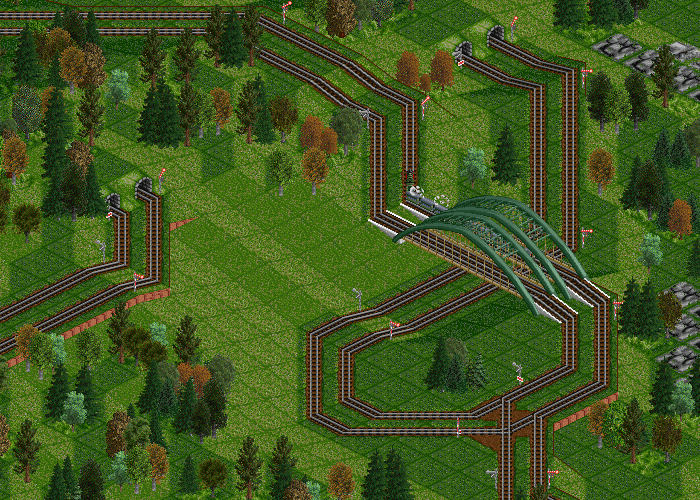
Part of the difficult mountain line to Niebüll was including the line between Niebüll and Kirchhain. That one is actually part of the bright green depot lines, which were then added to the network next. This one is actually a smaller network with just four lines. As most of the area is rather flat in that corner of the map, this construction was finished quickly. By that point, it was early 1925 by now, we had reached the city of Alfeld, which would be housing two rather longish lines towards Hagen (or somewhere there) and Drensteinfurt. The latter line was the first to be built, the area with the many cities around Hagen was to be left for last.
The screenshots actually show the complicated line to reach Niebüll located atop a mountain.
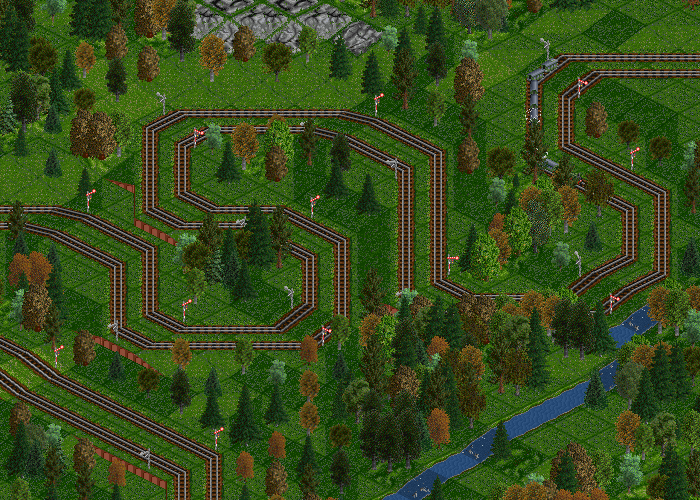
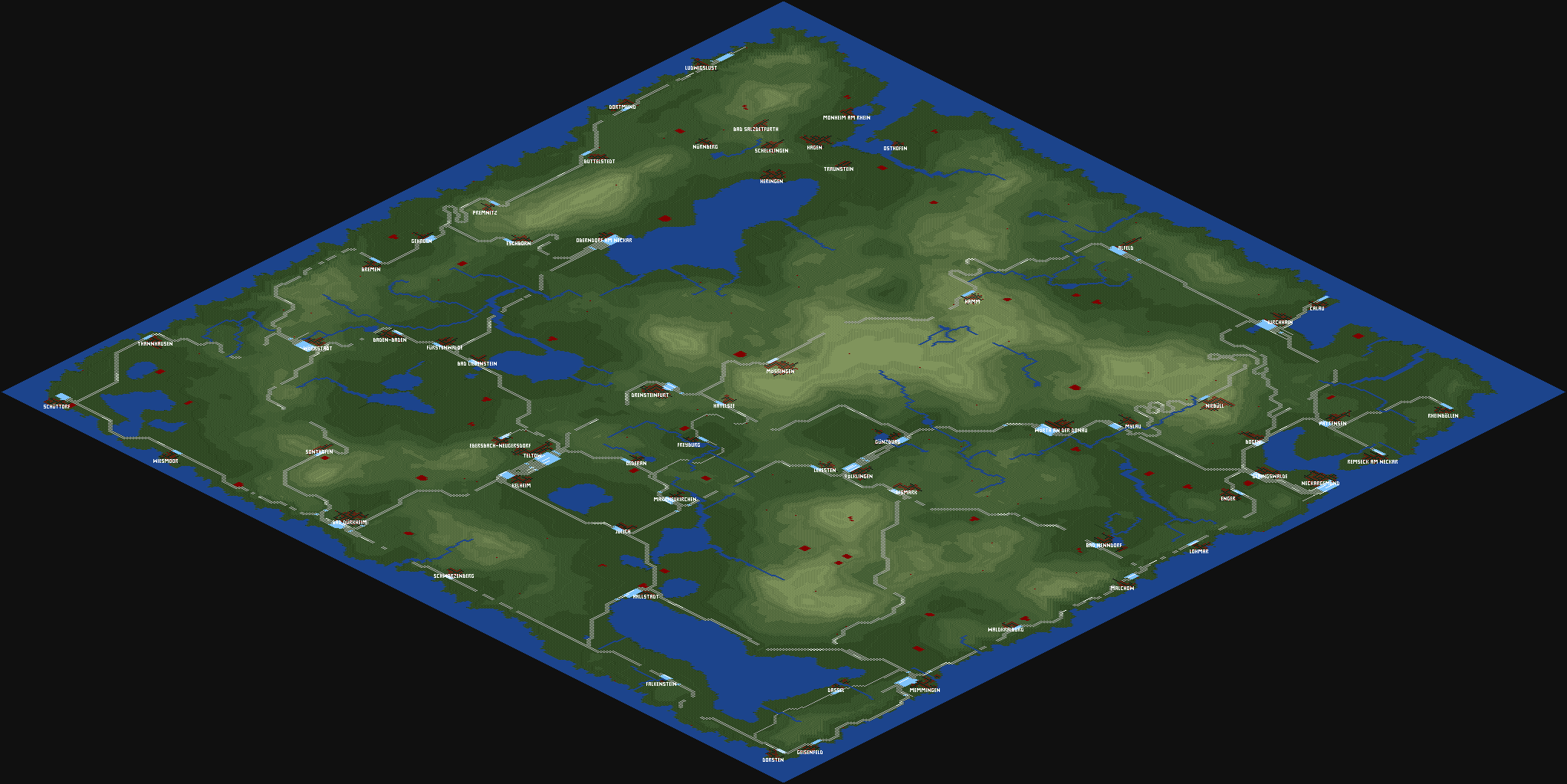
As these two lines were completed in just under two months, it was time to concentrate on the last two depot places, the yellow and blue ones, with the whole area around Hagen forming the final additions to the network. The yellow one was relatively easy, with connections to Drensteinfurt and Gehrden through easy terrain. There also was a connection still missing from the very beginning, from Teltow to Oberndorf, which was built quite differently from the original plan. The blue depot and station at Ludwigslust proved to be a challenge due to terrain, as the station had to be built quite far from the city center. It took some trickery to actually make it accept passengers to allow the city to grow.
By late summer of 1925 the whole network was completed except for the area around Hagen and the three lines leading there - from Nürnberg, Oberndorf and Alfeld. So it was now time to take a closer look at the situation there, to decide whether to actually define another depot area there, or to maybe just service the cities by trains from the other depots. As space was scarce around the cities - six cities in smallest distance to each other - the latter proved to be a tempting idea. So, another screenshot was taken with the network that existed so far, which was then edited to show the lines as per the original plan, and also the additional lines that were still to come.
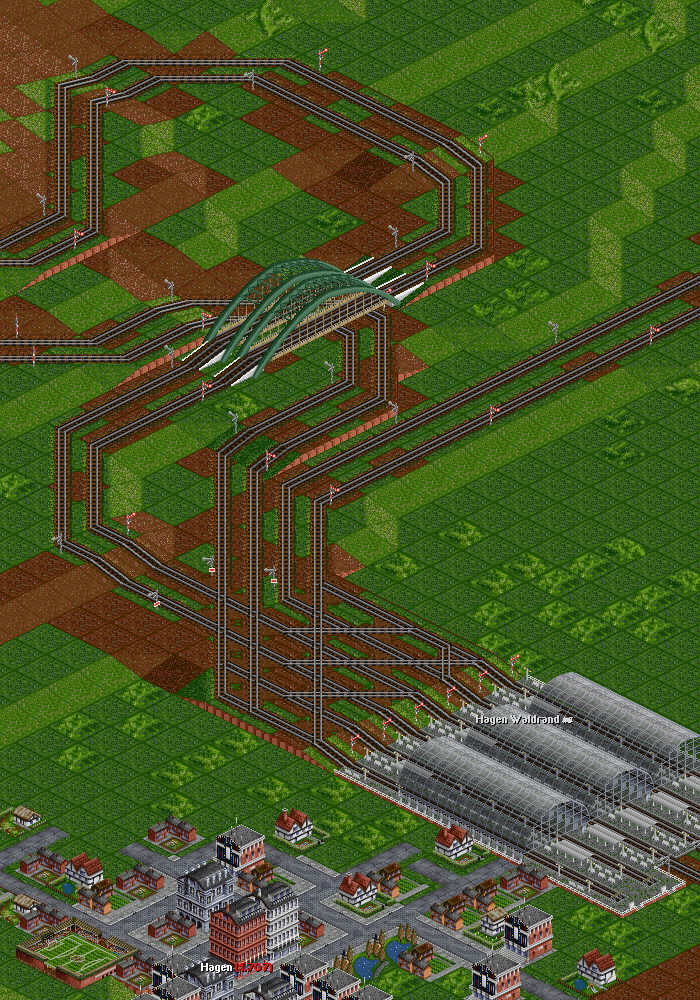
After a bit of back and forth, an idea emerged. Hagen would become the central station of the area, as it was the biggest city. Trains from the three depots of Ludwigslust, Oberndorf and Alfeld would form lines to go to Hagen in different ways, thus serving stations in all the cities. The main problem for the whole setup would be the steep slopes west of Hagen, towards Bad Salzdetfurth and Schelklingen. There was not much room to tackle them, and the necessary terraforming caused major issues with the involved cities. This was also the first time in the game that some major work was done to change riverbeds. East of Hagen huge changes to the landscape were needed by raising land from sea level in order to get the station and all the tracks needed around it to be in place. The whole undertaking cost approximately two million bucks, but with trains raking in double digit millions per year by now, that was not an issue anymore. And thus, by September 1925, the original plan had been turned into reality - with some changes here and there, but the overall idea was followed through.
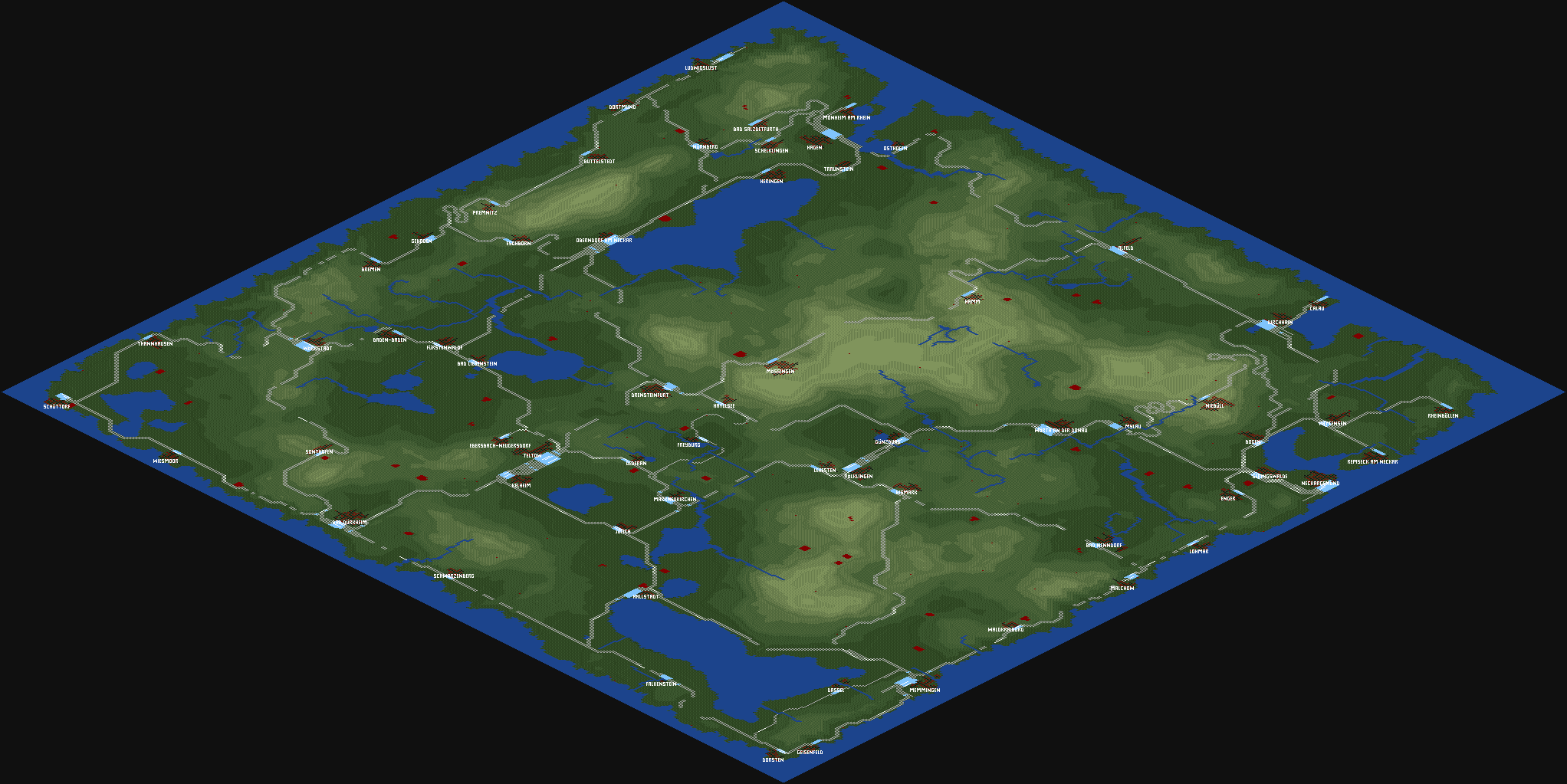
The following six months were spent consolidating the lines - which basically meant adding trains where there was not enough capacity on the lines, mainly for transporting mail. In late 1926 new coaches became available, which started lots of replacement work to get all the trains upgraded, as the newer coaches had a considerably higher capacity which was definitely needed. In parallel some stations were improved, especially the terminal station at Neckargemünd which turned out to be quite a bottleneck. Fortunately JGR's patch pack contains the patch for templated train replacement, which made the whole replacement a breeze: Just define the new train setup, and replacing almost 200 trains was then done completely automatic - which was largely helped by the fact that all trains regularly visit a depot for maintenance anyway.

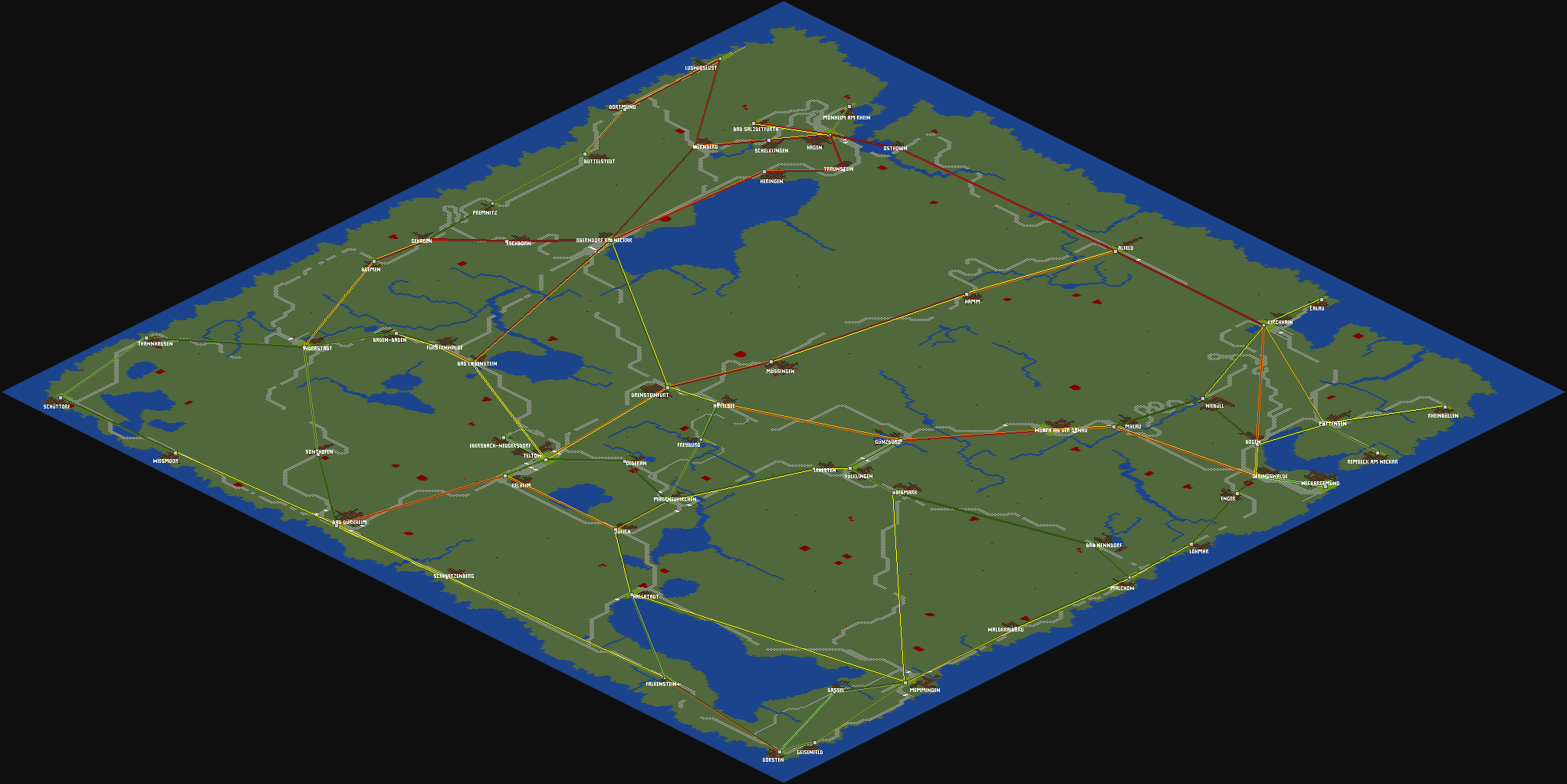
The map shows that the capacities on the lines in 1925 was way too limited in many places. Additional trains were bought and added to solve the problem - only to create new bottlenecks elsewhere...
Faster services
So, by November 1926 all trains had been upgraded, it was time to start the next phase: introduction of faster services that would not stop at every station. By now, faster engines had become available, coaches that would allow more than 100 kph also had been introduced earlier in the year, so a new plan for such connections had to be drafted. The main idea is to keep the depot areas as they are, but provide connections for longer distances between the stations which fulfill one of the following criteria: The city needs to be rather large to generate enough traffic by its own, or the station serves as hub where people exchange trains. Any small station along a line will be just skipped. A secondary goal is to provide new connections without the need to change trains in between. The new service category will be dubbed "fast train" ("Eilzug" in German, literally meaning "a train that is in a hurry"). Later on there will be a category of dedicated express trains that will only stop at the biggest stations, but the introduction of that will have to wait until proper rolling stock is available.
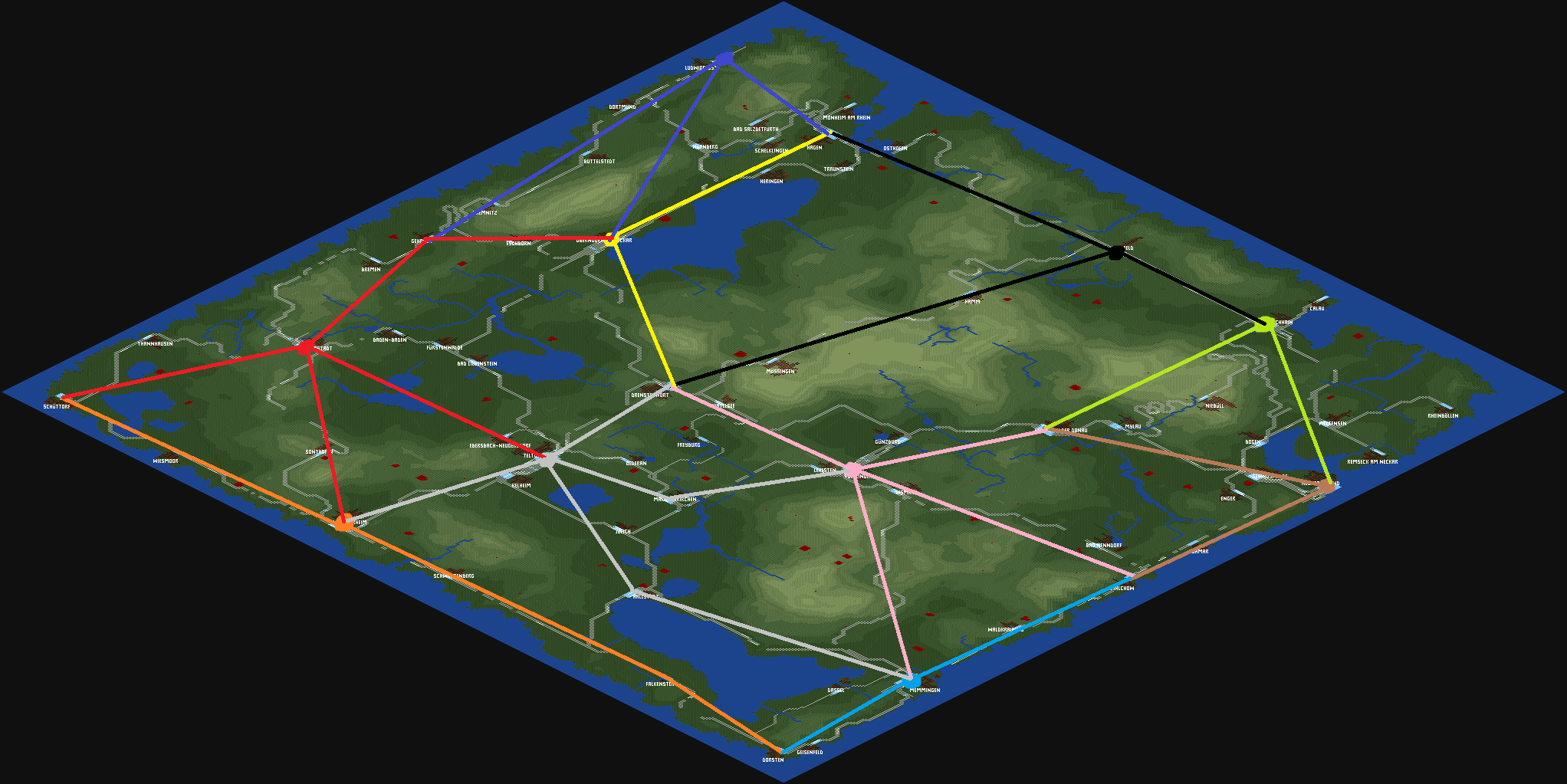
Drafting the plan was easy enough, but it showed that certain lines and especially stations will have to be upgrade: The new trains are planned to be longer than the local trains (which are 5 tiles long). The new ones will be six tiles long, meaning the stations will have to be lengthened where necessary. Also, at least for the planned connection between Kirchhain and Wörth an der Donau, there is the issue that the line goes up and down a steep mountain. This will be hard on the steam engines with such a long train, so there are two options: Either the train will circle around the line by heading for Boden and then towards Wörth an der Donau, meaning a new connection to allow him to get from Boden towards Wörth an der Donau is needed, or electrify the line via Niebüll. Based on the fact that the fastest electric engine reaches 90 kph, whereas the steamers of class 18 get up to 115 kph, and the line around the mountain is actually shorter due to all the serpentines on the mountain line, the decision was made to go around the mountain for now. Still, that line is a prime candidate for electric trains once they are a viable choice (Spoiler: It never got electrified). Finally, all stations that will be skipped will also have to be upgraded to actually allow the faster trains to overtake local trains that stop there. That means at least putting in switches, adapt signalling and maybe adding an additional platform. So, the plan for 1927 is set, there is a lot to be done throughout the network.
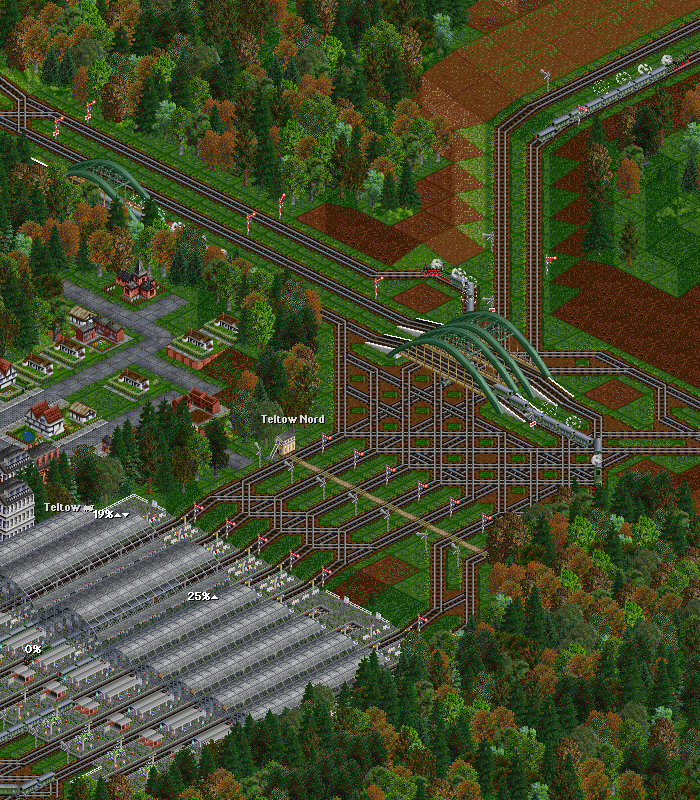
The first line of the fast train network to be completed was the orange one, with two trains running back and forth along the Southwest border of the map. Before going on with the two lines of the red network parts, the station of Teltow required a major overhaul of the Northern station entry. One more platform, some platforms changed from terminal to through platforms and vice versa, all to reduce the frictions between the three lines branching off on that side of the station.
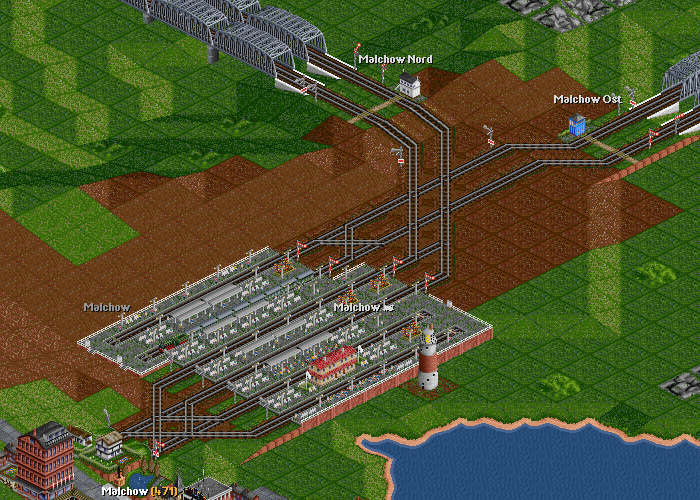
The introduction of the fast trains took well over a year, only by the end of 1928 everything had been set up. In between there were negotiations with city councils concerning bigger stations, a couple of lost trains due to mishaps when placing signals and a lot of trial and error regarding the number of trains needed for each line to get the capacities right, the introduction of the fast trains had impacts on the passengers to be transported by local trains, so once the system is up and running, some local trains may be put back to reserve duties or moved over to lines where there is more need for capacity.
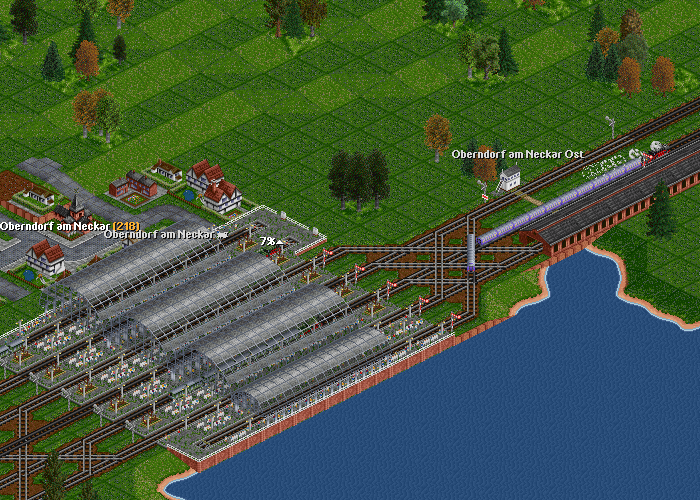
However, while being busy introducing fast trains, the industry decided to introduce the possibility to create luxurious express trains. These will form the third layer of rail transportation on the network. The bottom layer are the local trains, currently all hauled by class 38, five tiles long and running at up to 100 kph. The fast trains are hauled by class 18 at about 115 kph, with the trains being 6 tiles long. The express trains will come in at seven tiles and should be a bit faster still. The only engine that would be available is the E16, which, as the name suggests, is an electric engine. There's two problems with that: First of all, no line on the network is electrified yet. Second, the industry guys that came up with the express passenger coaches are opposed to electric traction and require to use a steamer of either class 18 or the (yet to be introduced) class 01. So that will delay the introduction of an express passenger network a bit, which is totally fine, as I first would have to make a network plan anyway.
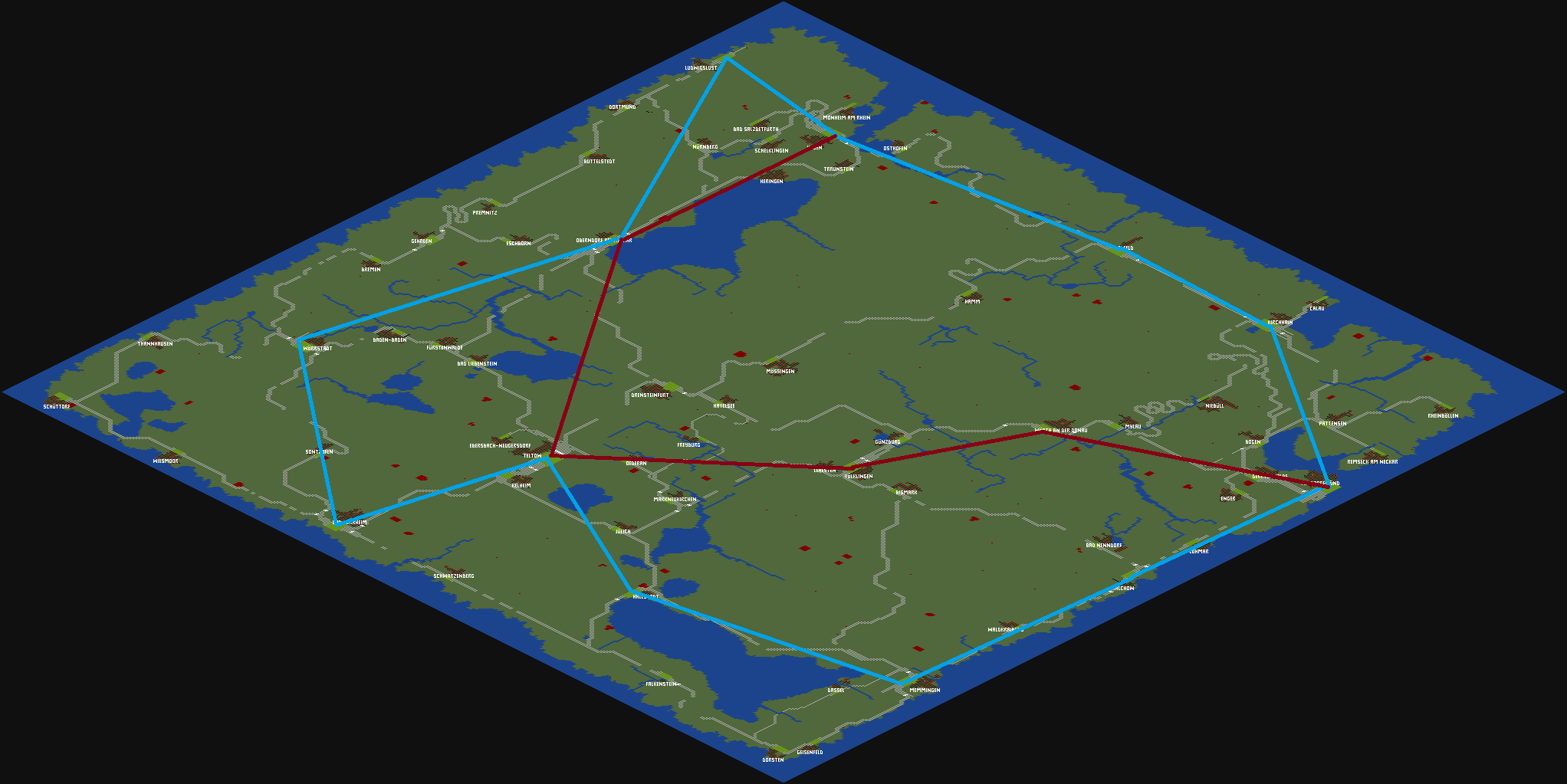
The network plan became surprisingly simple - two basic lines were conceived, a ring line connecting the biggest cities in both clockwise and counterclockwise direction, and a second line cutting the ring in the middle so to say. For the time being these would be run with class 18 and Rheingold coaches. These would struggle slightly at some slopes, but the track layout had been good enough to not cause huge issues.
An unintended side effect of the introduction of these express trains was a huge shift in passenger streams - until now the local trains had transported most of them, but now with long-distance connections becoming available, passengers wanted to use these to get to their destinations faster. That had two or maybe three consequences: First, more express trains, to cope with demand. Second, improve some stations yet again as they struggled to cope with the sheer number of trains. Third, reduce the number of local trains.
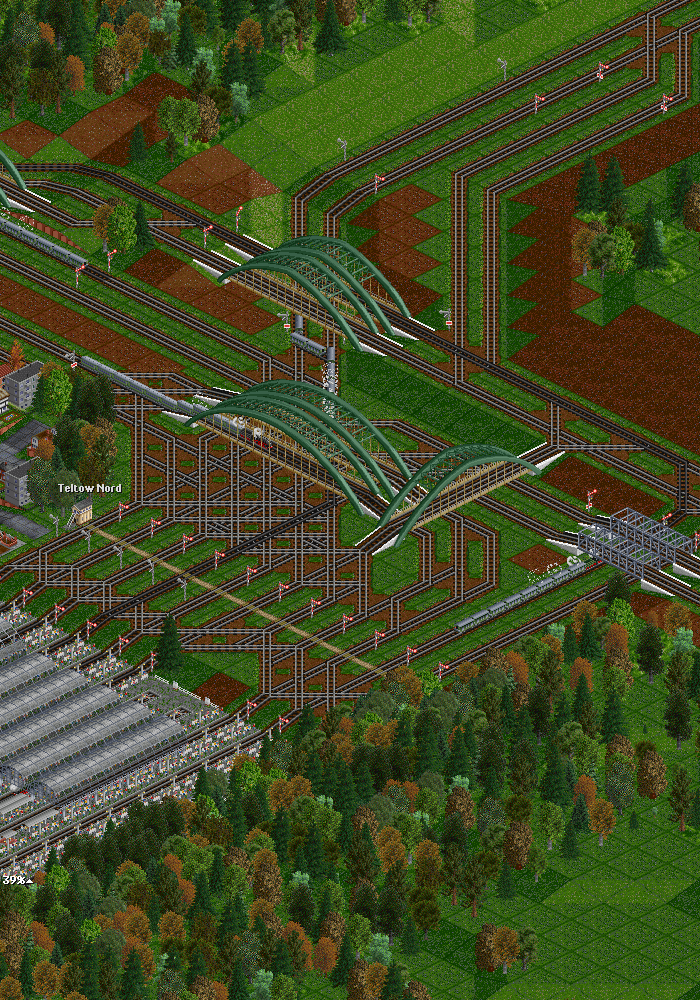
Some local lines were only utilized by less than 20% by now, some trains basically ran around almost empty, not only making little money, but also causing lots of congestion around the important network hub stations. That of course should change to improve our total efficiency. Each line of the original local service plan from the beginning of the game was investigated. In many cases there were five or more trains assigned to such a line, which by now was total overkill. The trains that were not needed anymore were not scrapped, after all they were at most 7 years old, but kept in the depots for now. If needed this would allow assigning them to other routes or services. In many stations mail was clogging up, so maybe some additional mail trains might be required, and why bother buying new rolling stock if you have unused vehicles sitting around?
It turned out that most of the fast train lines as well as the express train lines had opened up new connections which caused mail to sit at the major stations. Most stations had several thousands of mail bags sitting around, so I had to set up a dedicated fast train network for mail only to tackle the problem. This in turn caused rebuilds for several stations to reduce congestion. Oberndorf am Neckar was extended, as was Hagen, Wörrstadt got additional tracks leading in and out of the station to improve traffic flow, and Teltow was upgraded to now have 13 platforms plus a totally revamped northern entry as trains repeatedly warned about not being able to continue. Völklingen was also extended, although the crammed location in a valley between two cities made this rather difficult. And so I was busy throughout the first half of the 1930s to just figure out ways to improve the network in order to reduce the load on stations by improving connections.
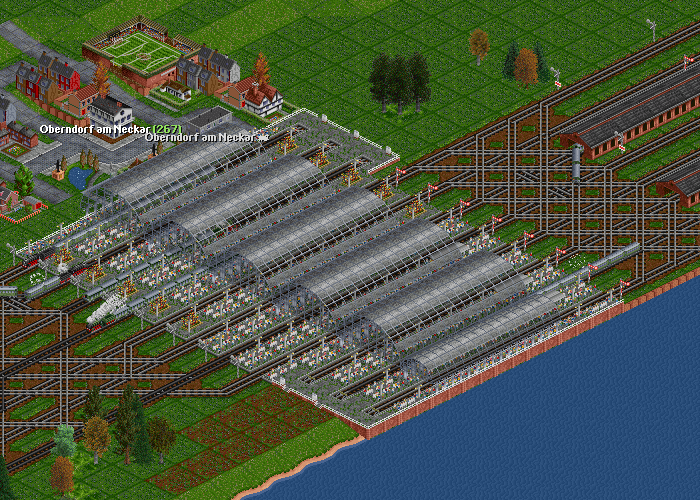
Based on the analysis of the freight connection network I concluded that my original plan of the fast train connections did not hold up to reality. And if you have a choice between a plan and reality, you should always choose reality. That resulted in some additional fast train lines to be introduced as passenger and mail demand was higher than what the existing lines could handle.
One very interesting example was the little city of Salzdetfurth, near Hagen. A passenger line served it, running from Alfeld via Hagen to Salzdetfurth. The problem was simple: There was huge demand between Salzdethfurt and Hagen, but little demand between Hagen and Alfeld, which is a much longer run, where passengers would choose a fast train without intermediate stop over the local trains that stopped in some villages along the way. In any case, the small station of Salzdetfurth suddenly was the one with most cargo (passengers+mail) waiting in the whole network! As all that was routed via Hagen anyway, as that was the only way to go from there - Salzdetfurth is end of the line as it is high on a mountain - this was now the time to introduce electric passenger transportation.
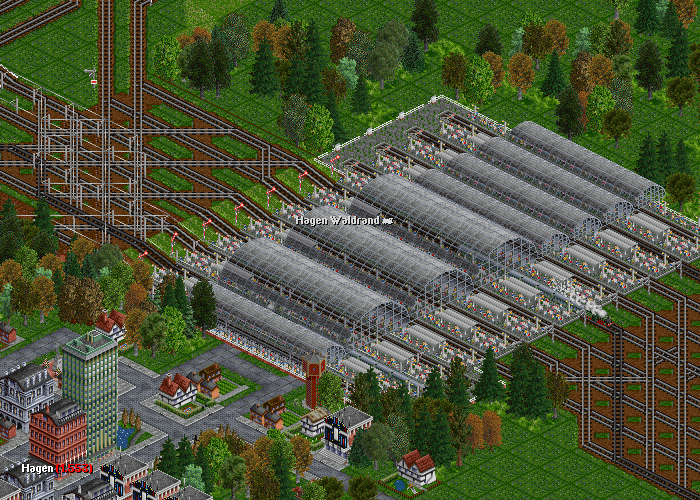
Hagen finally got a depot (which was not part of the original plan, but as noted, in the clash between plan and reality, reality always wins), which was only for the new passenger and mail line that runs between Hagen and Salzdetfurth. The engine of choice was the E 52, an early passenger engine capable of doing 90 kph even on the challenging uphill section, where the P8 steamers slowed down considerably. With two trains in place, one for passengers, one for mail, the pile of waiting cargo was now held in check and I could concentrate on other stations. Problem with that whole thing is that you are never done: Once you have improved one station so that it gets the cargo transported away fast enough, it will start piling up elsewhere.
In 1934, a big disaster happened. Near Bad Liebenstein, where the lines Teltow-Oberndorf and Wörrstadt-Oberndorf meet, some trains got stuck because I had not paid attention to the distances between the junction and the next station. The trains got stuck, I got notified that trains could not continue and had to do stuff to unstuck them. Unfortunately that resulted in two trains colliding, killing some 200 unfortunate passengers. That should not have happened... The offending junction area got rebuild completely to avoid trains getting stuck there ever again. Cleaning up the mess took some time, the line from Oberndorf was totally jammed, and the amount of cargo waiting at the stations skyrocketed.
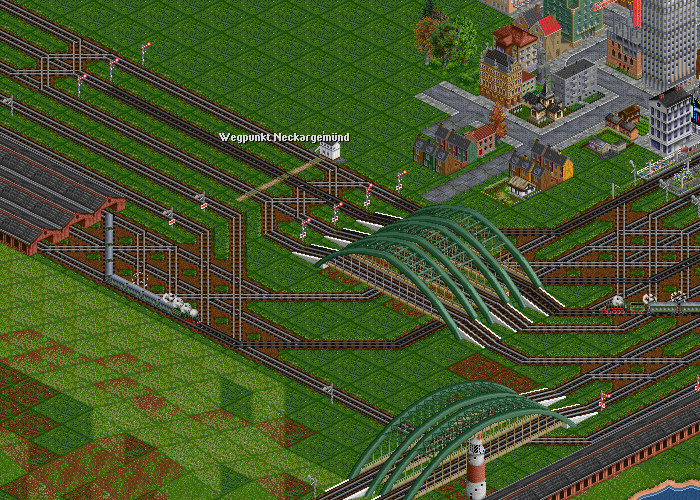
The biggest rebuild of the stations in the network happened in Neckargemünd. Due to limited place the depot area had been crammed next to the station, causing lots of conflicting paths, congestion between the depot and the station, and general unhappiness with the performance. To fix this, a special feature of JGR's patchpack was used: drive through depots. Place to depots next to each other, and you can make the train service while going through the depot and coming out at the other end. Great stuff. That reduces the conflicting paths by 50%, as one can now optimize the depot entry and exit. With that in place, all regional trains now use one of three drive-through depots between Geringswalde and Neckargemünd, while the few long-distance trains that use the depot Neckargemünd are served as usual. Of course I had to stop all the local trains for some time to get all that rebuild done. The numbers for waiting cargo of course went through the roof, but sometimes things have to get worse before they can really improve. In any case, the station of Neckargemünd is now much more performant than before, allowing multiple trains to enter and exit simultaneously without crossing each others paths and causing disruptions. The station of Geringswalde, while only served by local trains, by now also has eight platforms. The long-distance trains from and to the direction of Malchow now use a shortcut, bypassing the stations of Enger and Geringswalde.
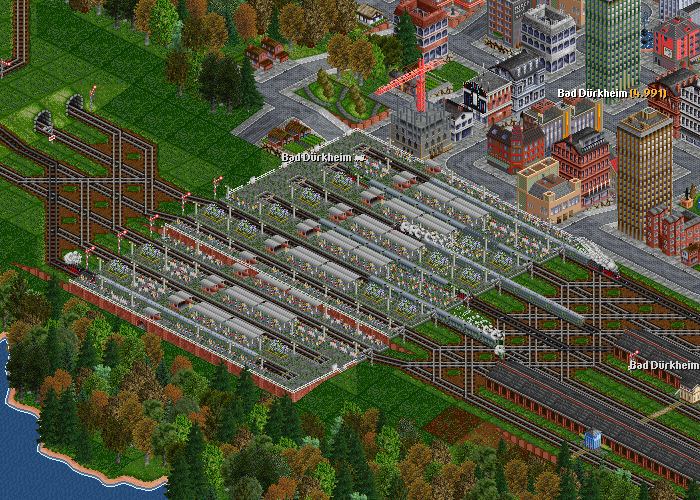
Towards the end of the 1930s I finally realized where my all my troubles came from: First of all my configuration was somewhat messed up, causing cities to generate way too many passengers and way too much mail in general. Second, the setup of the fast trains and express trains was a total mess that did not take actual demand into account in any way. So that was a disaster waiting to happen. Well, it took 15 in-game years to figure out that I was fighting a losing battle... so either the disaster was coming really slowly, or I was really doing quite well to keep everything up and running. Nevertheless, now that I realized the fast trains and express trains need to form a proper network to allow connections between the big hubs - between all of them - that is, it is now time to go back to the drawing board, in order to come up with a new setup.
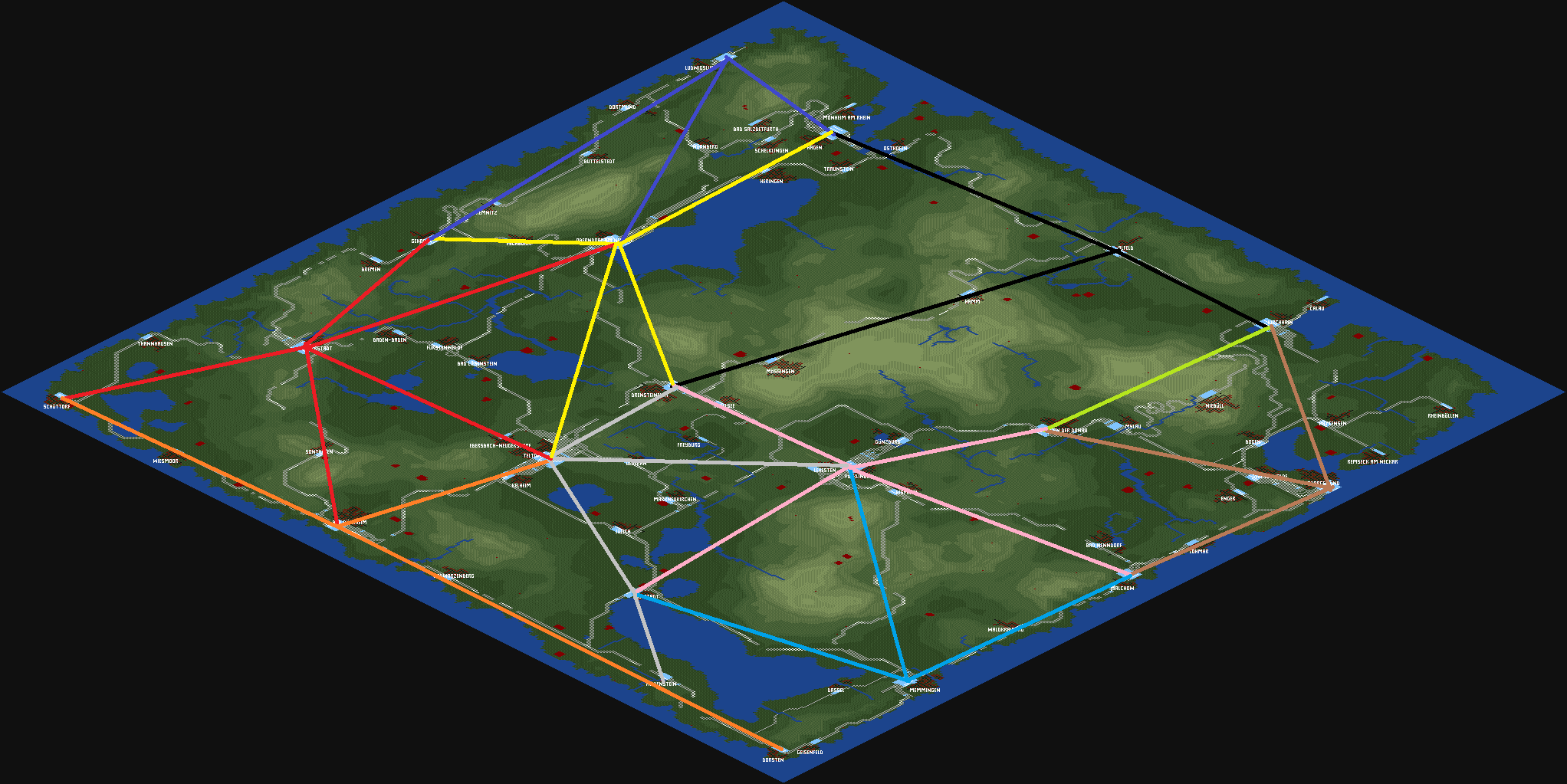
The first side effect was an overhaul of the line plan, to reduce the load on some of the hubs, especially Teltow. The line between Völklingen and Drensteinfurt was extended by setting up a shortcut west of Völklingen, which reduces the travel distance and removes the need to pass through Günzburg. Two new small bypasses near Markneukirchen and Jülich now also allow a direct connection between Völklingen and Hallstadt. As far as the line does not have any intermediate stops anyway, such as between Memmingen and Hallstadt, all local trains are to be upgraded to fast trains. Finally, in order to allow better balancing of the trains across the network, the trains will only travel between the hubs directly, and not - as before - doing more complex connections such as Bad Dürkheim-Teltow-Drensteinfurt. That caused uneven distribution as the lines have different distances, travel times and passenger demand.
Finally, the local trains between Alfeld and Hagen are discontinued. The only intermediate stop was at Osthofen, and that is right next to Hagen, it makes more sense to extend the electric line from Salzdetfurth via Hagen to Osthofen and have local trains run there. Similarly, a local train between Monheim and Traunstein with Hagen in between can be created later on. While planning that part I also thought about fixing a couple of issues with the pathfinding and the signal restrictions which gave me repeated trouble here and there. All in all, it boiled down to basically a complete reset of the service structures - the local trains would stay the way they were, but all fast trains and express trains were sent to the depot (which took quite some time to get them there), before starting to set up the new lines.
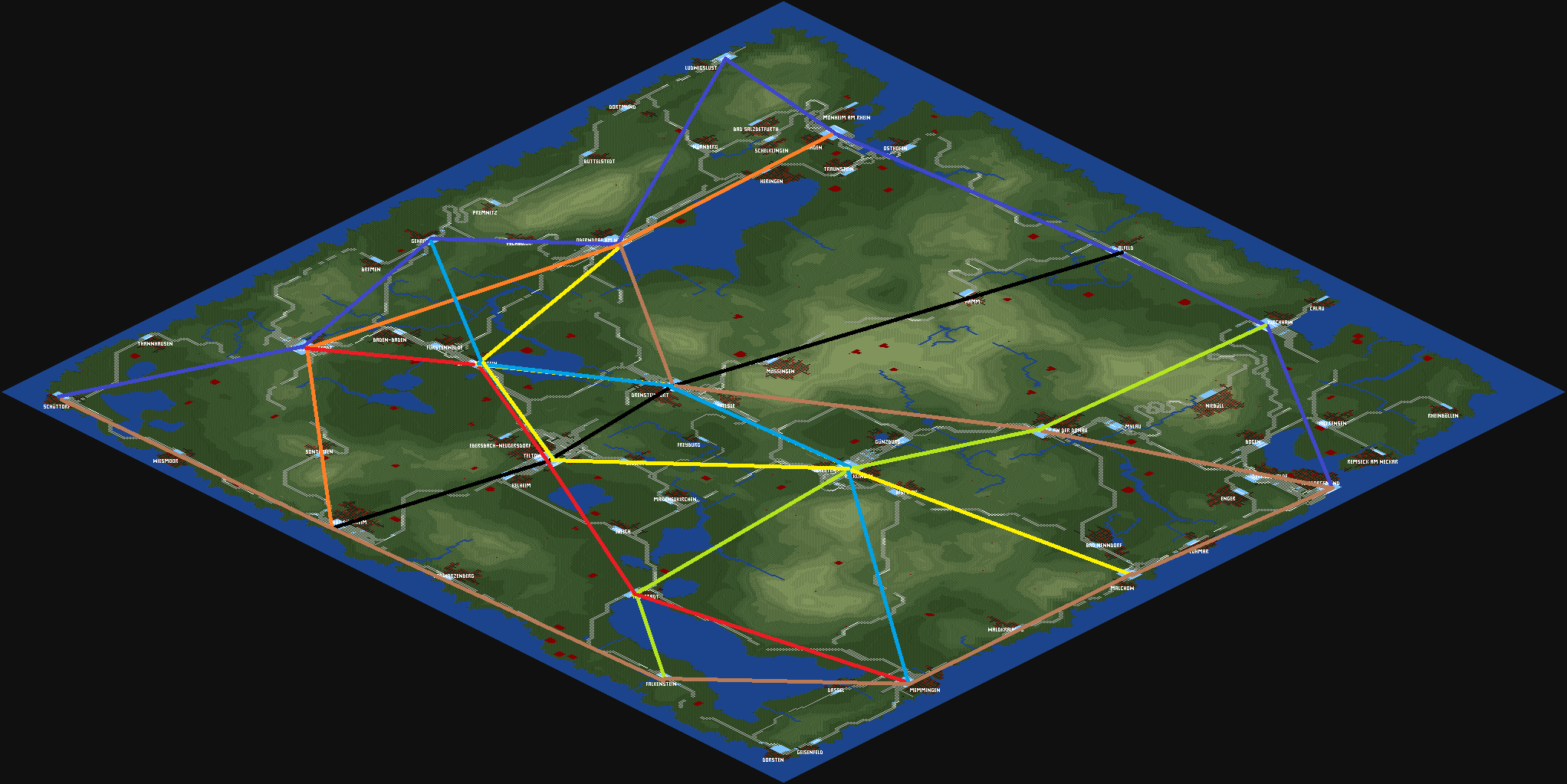
As a result of all the line reshuffling I was able to actually get rid of about 160 out of about 300 trains. All lines for local and fast trains are now split up into dedicated passenger and mail trains, with each line being served by one of each to get going. All unused train were moved into an extra depot to just keep them in storage. Then I actually started looking into passenger demands to set up express train lines. That resulted in a huge increase of such lines and additional changes to the network: Some stations that were only served by fast trains (up to 6 tiles long) will also be served by express trains (7 tiles), so station extensions are needed in Gehrden, Schüttorf, Falkenstein and Drensteinfurt. The station of Dorsten will finally be turned into a through station, something I had originally planned since the start of the game. This seemingly small change will then allow to have a direct connection from Bad Dürkheim via Falkenstein to Memmingen, something that was not possible before - passengers for that route had to go via Teltow, and the line between Teltow and Bad Dürkheim was chronically overloaded. The station of Wörrstadt was also extended with a terminal platform in eastern direction.
It took about two in-game years to get everything sorted out. One important part was to fix some of the routing restrictions at the stations, a feature of JGR's patchpack that allows to send trains towards the correct platforms. That is important in my game as I do not allow trains to turn around except when reaching the end of the line, so I need them to go to the correct platforms if the station has terminal platforms and through platforms.
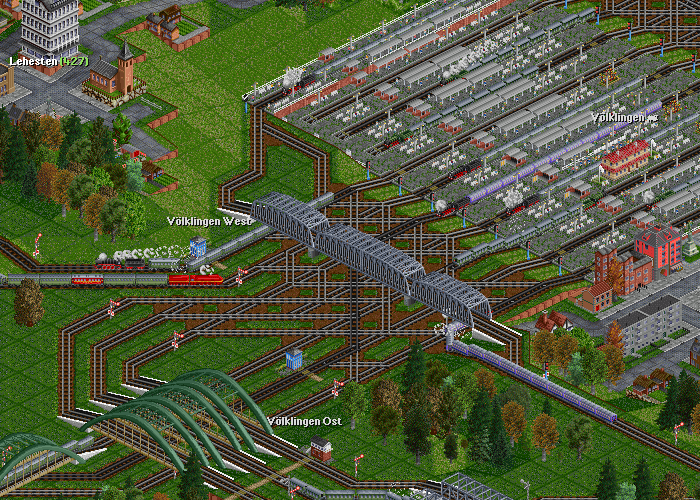
It turned out that some of the fast and express train lines needed additional trains. Unfortunately, the Rheingold express coaches were unavailable by now, so additional express trains were now run by class 05, a high speed engine capable of about 160 kph, as long as the terrain is flat. A couple of local train lines also needed the additional train here and there, but all of that could be managed by reactivating older trains from the storage yard. By the mid 1940s all lines were finally running smoothly, no stations got overcrowded anymore. At that time around 300 trains were owned by the company, out of which about 80 were still standing around in the storage yard.
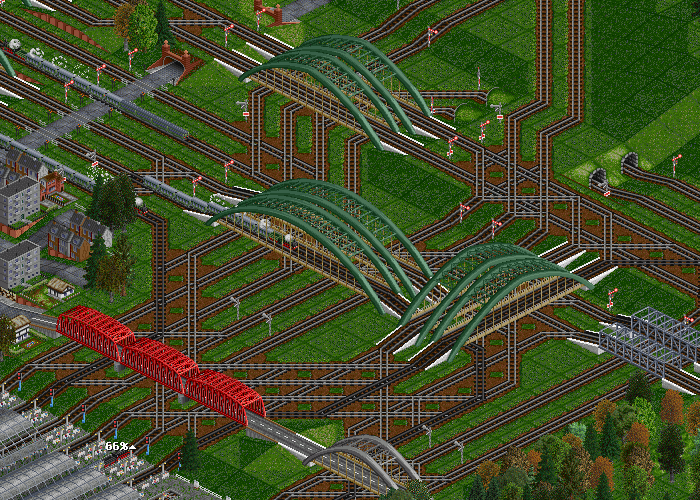
The next actual change to the network was the introduction of a small electrified circle line connection the three cities south and west of Hagen. As Hagen already had some electrification going on earlier, it was only natural to expand further from there. A full scale electrification is still a plan for the future, at least until newer electric engines become available.
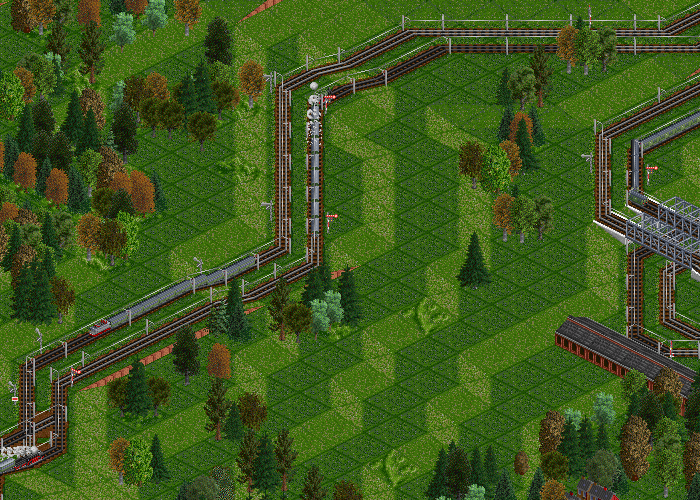
Closer examination of the waiting passengers (or rather the destinations they were traveling to) revealed some insights about missing connections. Passengers between Drensteinfurt and Wörth an der Donau always had to go via Völklingen, which required a train change there. Similarly, many passengers actually wanted to travel further from Wörth an der Donau to Wörrstadt or further west towards that corner of the map. So a new line was built, creating a shortcut between Drensteinfurt and Bad Liebenstein to allow a direct connection from Wörrstadt via Bad Liebenstein to Drensteinfurt, and further via existing tracks towards Günzburg, where only a new corner connection was needed to allow trains to bypass both Völklingen and Günzburg to go directly to Wörth an der Donau. That also prompted two new lines, an express train line from Wörrstadt to Wörth an der Donau via Drensteinfurt, bypassing both Teltow and Völklingen, as well as a fast train running between Wörrstadt and Drensteinfurt. I did not add another fast train line between Wörth an der Donau and Drensteinfurt, there already are fast trains connecting both, although people will have to switch trains at Völklingen if they want to go that way. The express train therefore is the only one using that bypass near Günzburg, providing better travel times, so that passengers are actually inclined to use that express train.
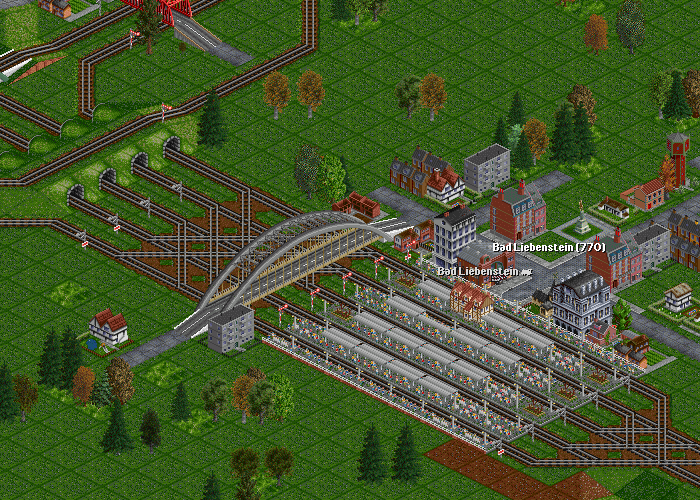
Shortly after these services were started, passengers started piling up at Drensteinfurt. Most of them came from Wörth an der Donau (or places further east from there) and wanted to continue towards Gehrden (or to cities directly connected to Gehrden somehow). However, there was no direct connection whatsoever, passengers either had to go via Oberndorf am Neckar, or via Wörrstadt, and capacities on both lines were already well used. So, yet another new line was planned, connecting Gehrden in a more direct way to Bad Liebenstein, bypassing the large detours via Wörrstadt or Oberndorf. That new line would be used first by a local train service connecting Gehrden with Teltow via Baden-Baden and Bad Liebenstein. The latter would provide ways to change trains to the new express line towards Drensteinfurt and further east. That would hopefully reduce travel times from around Gehrden towards the center and the eastern part of the map. An additional express line from Gehrden via Bad Liebenstein and Drensteinfurt would also have to be planned, but it was yet to be clarified where that line should then head to. One idea was to then go from Drensteinfurt to Völklingen and possibly further to Wörth am Neckar, another idea would be a continuation from Drensteinfurt to Wörth and then via some new line to Malchow. As you can see, lots of ideas came up, just by analyzing where passengers actually would want to go.
What I actually really missed was an overview per station to see how many passengers it would generate with what kind of destinations, just so that it would be easier to figure out what kind of connections should be offered.
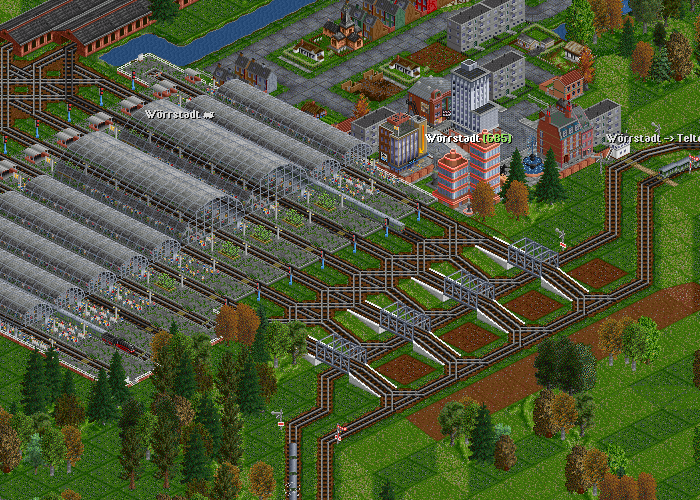
In any case, the network now seems really complete, at least for the time being no further new lines should be needed. Still, there is plenty of expansions to be done. Some crucial parts of the network are extended to three or four tracks as more and more trains are running there. One example is the section between Wörrstadt and Bad Liebenstein, with the stations of Baden-Baden and Fürstenwalde in between. Lots of local trains are using it, plus a rising number of fast and express trains. In the same way, some station entrances are updated whenever I happen to see that trains are queuing up.
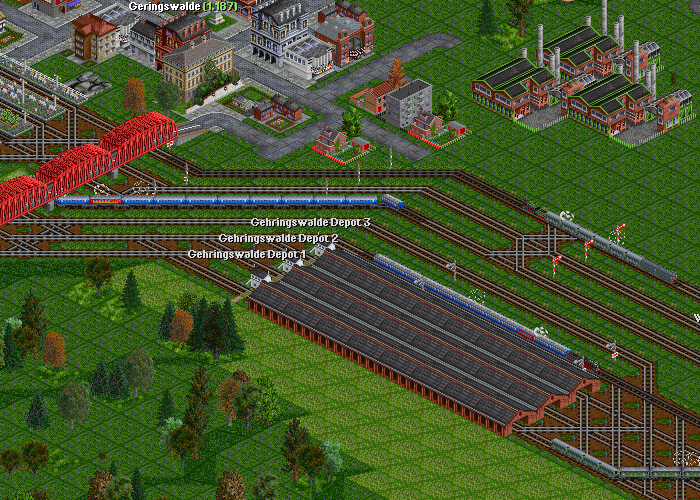
By 1950 new long-distance coaches are introduced. With these, the old express trains from the late 1920 (and the later additions which do not match livery-wise) are consolidated. The relatively new class 05 is sidelined (in the real world, only three units had ever been built) in favor of the sturdy class 01. All express trains now come in a blue color, with a red dining car in between. New engines are planned to be introduced by the mid 1950s, but we yet have to get there. At the same time, plans for electrification are ongoing, as the industry has hinted (or maybe I'm just in possession of a looking glass...) that until the end of the new decade several new electric engines will be introduced to replace the old steamers. The first goal is to speed up the express trains to provide a proper travel speed improvement of the ordinary fast trains. Currently both are run by class 01's, so there is just not much of a difference. The 01's will not be scrapped, but take over services from the even older class 18, and those will then be retired to reduce the number of different types running on the network.
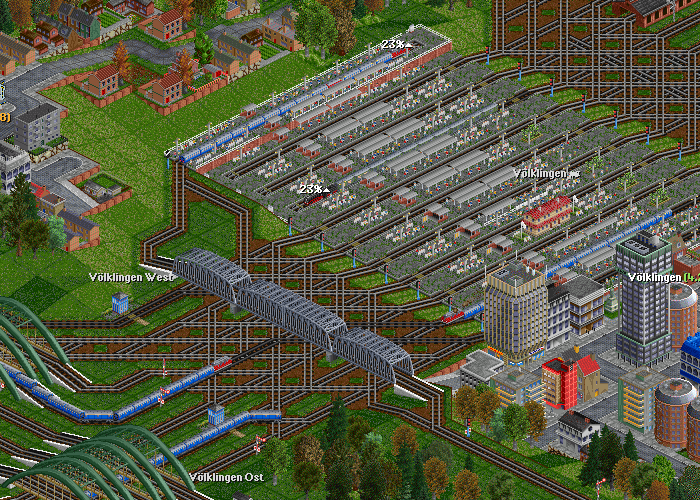
In 1956 the new diesel engines finally became available in order to carry out that plan. All express trains for passengers and mail were changed into the blue livery of "F"-trains with the older steam engines of class 01 being demoted into fast train services, replacing the slower class 18. Well, some of them at least, there are still a couple in service as it does not make sense to replace them with newly built steam engines at this point in time, but I also do not want to add further diesel engines for fast trains as it will only be a matter of time until electric engines become available for the next series of upgrades.
Timetables
A completely different topic came up in the meantime: Proper timetables. I repeatedly ran into issues where the stations were too small because trains on different lines bunched up and came to the stations at the same time. This is something that the automatic separation (only available in JGR's patchpack) can solve. However, it comes with another very powerful patch for creating timetables that are quite realistic, allowing to come up with plans to ensure that trains are somewhat properly spread out and to ensure good connections across the network - I am still losing a relevant percentage of passengers due to bad connections when changing trains. After all, who would want to sit around at a station for hours because the train schedules are not properly planned? So coming up with an integrated timetable across the whole network would be the next big step forward. That however required a lot of additional planning and spreadsheets to figure out the best way forward.
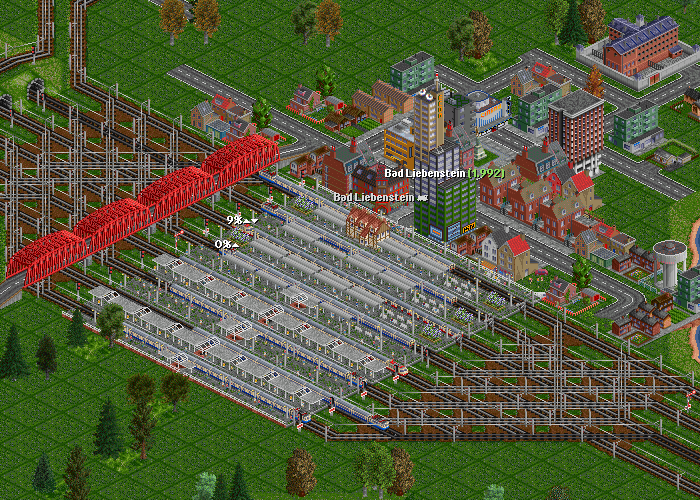
The idea in itself is pretty simple: Trains on each line should follow a clear pattern, that they should travel every two hours, or hourly, or even every 30 minutes. That would ensure proper spacing between the trains of the same line, and when coming up with proper plans across lines, it would allow for fast changing between lines. As simple as the idea sounds, getting it up and running for a large number of trains is a real issue.
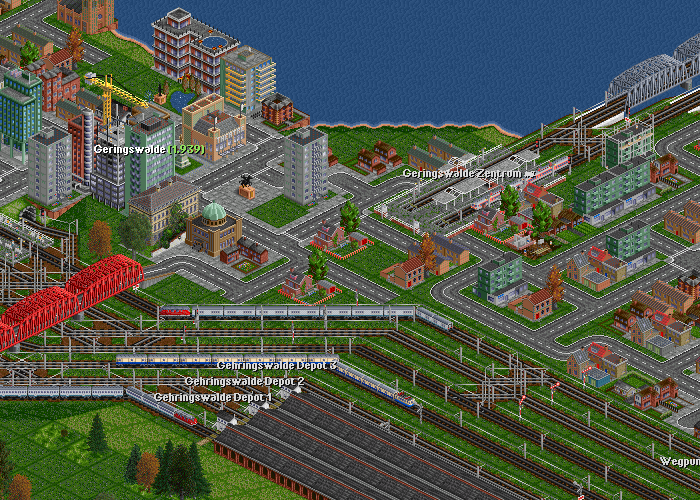
Setting up all of that took about three attempts, more than a decade of in-game time and about a week of real world playing. The first result with express trains and fast trains being timetabled for the whole map was ready by 1971. Throughout the 1960s I had to extend stations, as more trains would be at stations simultaneously. By 1970 I had all of that finished, but then the brand new class 103 was introduced, which elevates express trains to a whole new level, enabling travels at 125 mph / 200 kph. That in turn somehow caused new issues with the timetables, since now some trains showed up at stations way earlier than before, messing up all the carefully crafted plans.
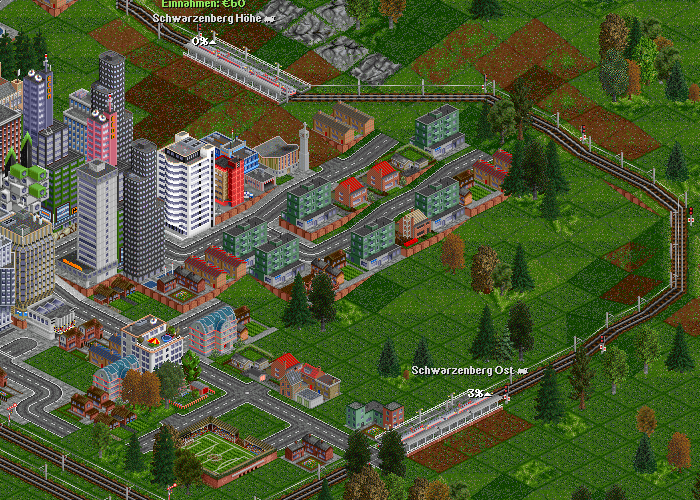
So, starting in 1970 a new plan was devised. The express trains run every two hours on each line and connect at all the different stations. The fast trains are then added on top to fill the gaps, so that for each and every line there is one train per hour. The network for mail transport looks exactly the same, but it is offset by 30 minutes from the passenger connections. That means most of the lines see a train every 30 minutes already. And the local trains have to be squeezed in between somehow as well.
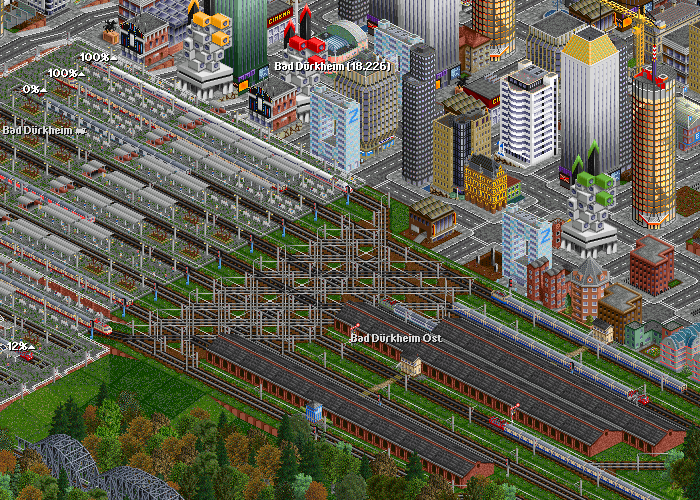
As a side effect of the whole planning, overhauling of the network and so on, all rolling stock was modernized: The express trains run exclusively on class 103, the fast trains use the class 110. Both are electric engines, meaning that the bulk of the network is electrified by now. The major non-electrified lines are in the east of the map, as no express trains are running there. Funnily enough I had thought at the beginning of the game that I would start with electrification exactly around Niebüll, now it looks like it will not get electrified at all. Some shortcuts had to be built to achieve the travel times needed to get the desired connections at the stations, notably between Alfeld and Drensteinfurt, where express trains now only need one hour.
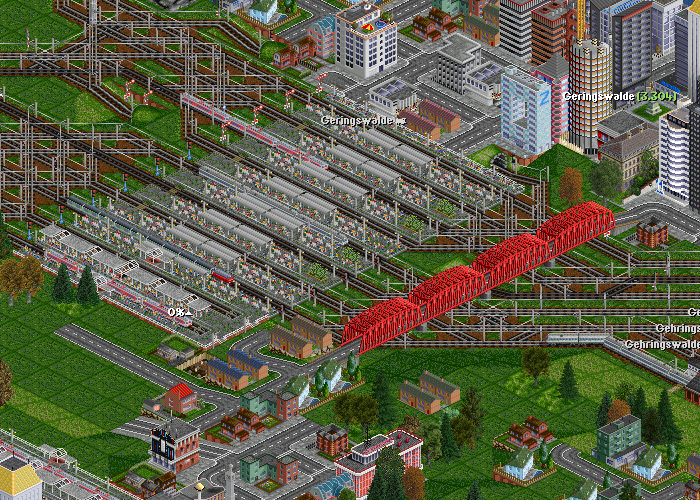
While setting up all the plans I created a spreadsheet to mark which trains would be at what station at which times to see potential conflicts and to count how many trains would be at stations simultaneously. As can be guessed from these paragraphs, timetabling is the embodiment of micromanaging. All in all, it took me about 20 in-game years (at reduced game speed!) to get everything up and running in a somewhat stable manner. While the express trains on their own had no issues, adding fast trains and local trains into the mix caused all sorts of delays, messing up my timetables, causing trains to stop in stations for prolonged periods of time, which in turn blocked platforms for subsequent trains, causing more delays and... you get the idea. I had to toy around with the settings on the timetables quite a bit to make it all more stable, add further platforms here and there and in some places change the track layout to allow more trains to enter and leave stations simultaneously.
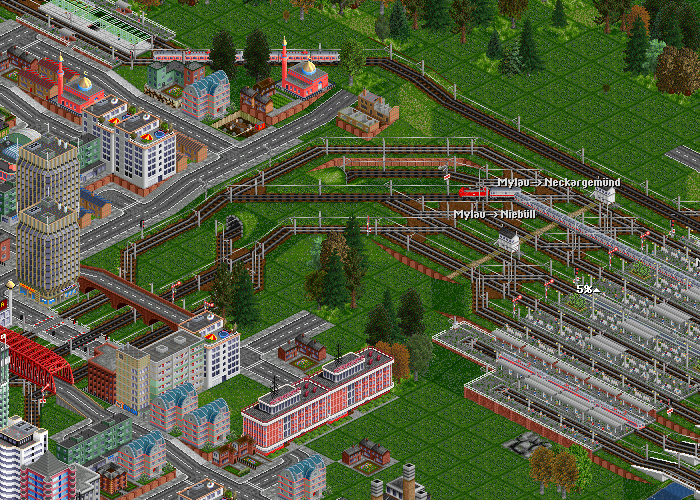
By 1980 it finally all ran smoothly, so I actually ran out of things to do on the map - all cities were connected, most trains were running on high load percentages, but still managing to carry all waiting cargo. Only some lines for fast trains had to be adapted to e.g. allow for fast trains running between Teltow and Bad Dürkheim every 30 minutes instead of once per hour. In a similar way, an extra local train was added to just run back and forth between the cities of Drensteinfurt and Mössingen (it had been in place before I added my timetabling adventures, but now it runs on a dedicated new track to not disturb the faster trains).
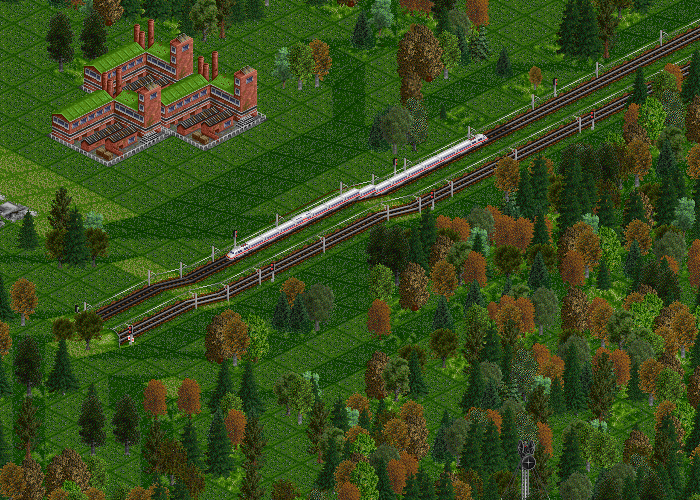
For some larger cities I now added small "S-Bahn" types of services, urban services in large cities or metropolitan areas with small stations within short distances. Those would run using class 420 EMUs or class 111 electrics, both of which come with a special override for local passenger coaches that allows loading an unloading in one game-tick, faster than anything else in the set. If you want to look up the real thing, look into S-Bahn Munich or S-Bahn Rhein-Ruhr. Do not confuse it with the systems in Berlin or Hamburg, which use third-rail, or with the system in Karlsruhe which is a hybrid system of trams that also run local services in the area. In any case, some of the larger cities on the map got some more small stations and lots of trains running in circles around them. The game is not really meant to design such kinds of services, you'd have to play something like Cities: Skylines instead I guess, or something from the Transport Fever series.
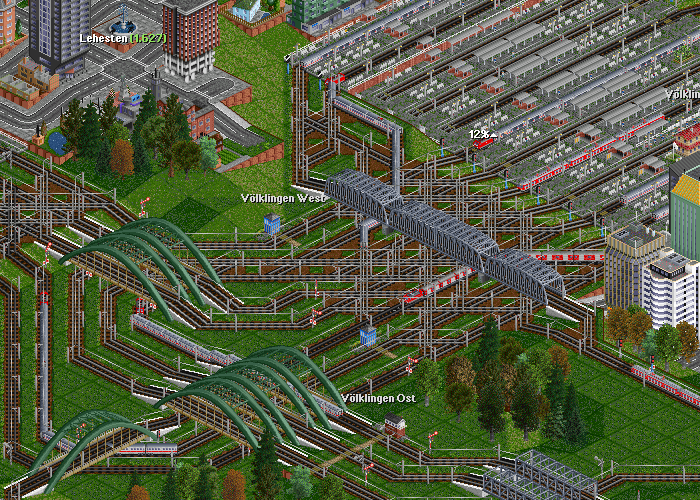
By the early 1990s the final phase of the game is reached: The introduction of the ICE high speed trains provides new possibilities for faster connections, but in order to make the trains reach these speeds, new dedicated tracks had to be built. However, there really is not much more room on the map and especially around the stations to make this work. I only added some additional rails to speed up the connection between Hagen and Oberndorf, as well as between Oberndorf and Wörrstadt. The other, more interesting new line directly connects Wörth with Hallstadt (which was only possible via Völklingen before), and then added a completely new connection from Hallstadt towards Bad Dürkheim. This now allows the introduction of an ICE connection between Bad Dürkheim, Hallstadt and Wörth, reducing the travel times considerably. This was based on an analysis of the passenger flows, as I got quite some passengers from Niebüll towards the general direction of Bad Dürkheim. With the existing connections, that connection was apparently too slow, causing the S-Bahn services around Schwarzenberg to make huge losses as they make the final trip on a lengthy connection involving several train changes.
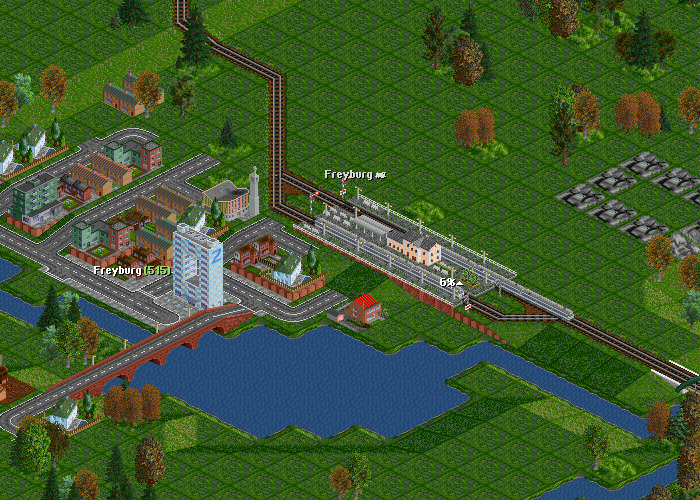
Long story short: In the year 2000, 80 years after starting the game, there are about 350 trains running about, earning several million EUR per game-month. Just about all trains are running on an integral timetable, meaning that the trains meet at the big stations at roughly the same time to allow passengers to change trains easily. All lines are running at least on an hourly base, some lines are running every 30 minutes or even more often. That seems to manage the amount of passengers quite well, even for the largest cities, which at this point of the game are at around 20000 inhabitants. I did not specifically do things to increase city sizes (like running bus services), that would have resulted in a totally different outcome of the game.
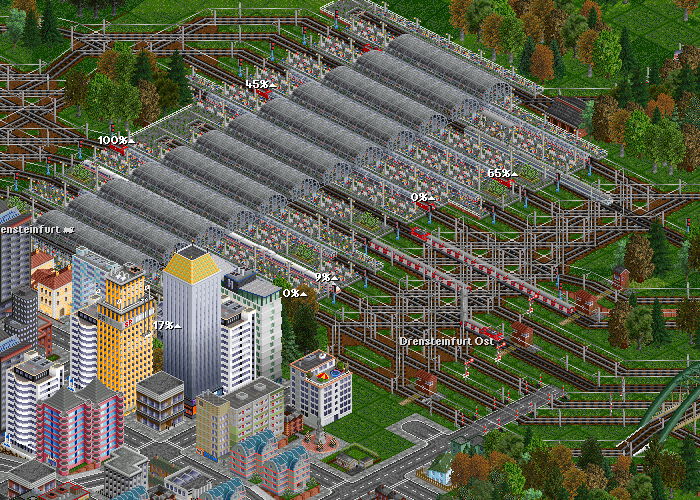
I could have played on for another 10 in-game years or so, upgrading rolling stock, but there was not much to be changed anymore, the biggest problem at this point was the ever increasing number of passengers, which would require major redesigns of various stations. That is something to be done in a new-game, with some of the lessons learned from this game will be taken into consideration.
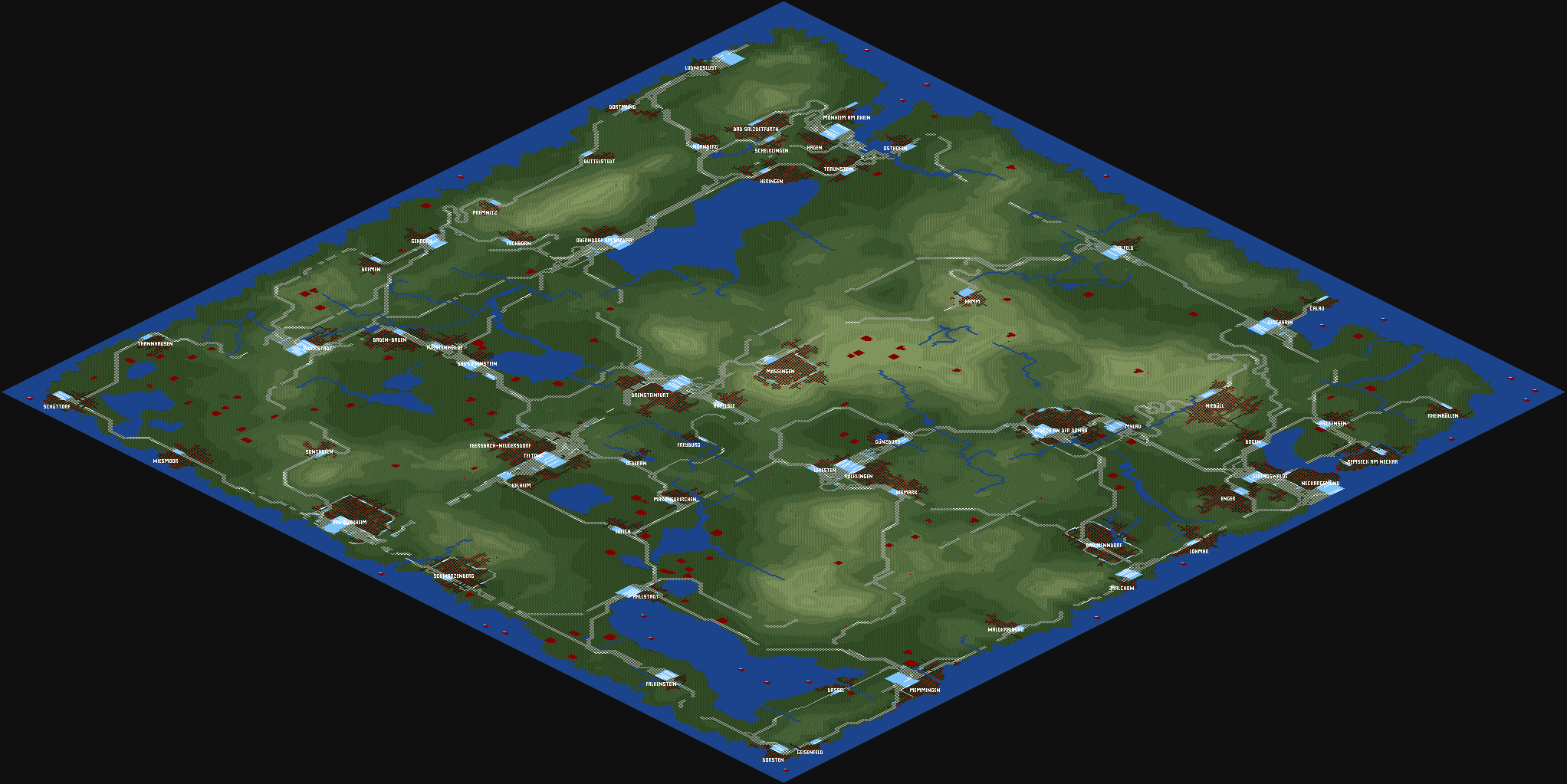
The final map of the game, showing how most cities grew. When comparing with the original plan, a couple of additional lines can be found (e.g. Malchow to Wörth an der Donau), and some lines got adapted, like removing some curves between Alfeld and Hagen, or a shortcut between Alfeld and Drensteinfurt. Most of the network is still based on the first plan from 80 in-game years ago.
Lessons learned:
- A 512x512 map is too small, and low density of towns is still too many of them.
- Templated train replacement does not work properly with the old DBSetXL :-(
- Three levels of passenger transportation need to be distinguishable (local trains, fast trains, express trains), with express trains not running on each and every line.
- Daylength factors and passenger production rates need to be balanced a bit more
- Too many cities grow too fast to my taste, the ratio should be reduced to one out of 8 or even less, not the default 1 out of 4
- Timetables are something that should be set up from the start, not after half a century of in-game time.
- Concentrating on passenger traffic using trains only gets boring once you have connected everything.
- Forbidding trains to turn around in stations unless it's a terminal platform requires overly big stations and might not be a good choice.
- Using signals with routing restrictions should be done using light signals from the start of the game to have a visual clue which signals use restrictions.
